The following list highlights some of the best places to visiting in Japan. So if you are in Japan, I recommend visiting the following:
- Jigokudani Monkey Park, Yamanouchi, Japan
- Kanazawa, Ishikawa, Japan
- The Atsuta Shrine, Nagoya, Japan
- Matsumoto Castle, Nagano, Japan
- Kenrokuen Garden, Kanazawa, Japan
- Shirakawa-go, Ōno, Japan
- Shira-Ito Waterfall, Shizuoka, Japan
- Hiroshima Peace Memorial Park, Hiroshima, Japan
- Itsukushima-Jinja gate, Hiroshima, Japan
- Mount Fuji, Honshū, Japan
- Chūbu-Sangaku National Park, Honshu, Japan
- Shirogane Blue Pond, Hokkaido, Japan
- Akan Mashu National Park, Hokkaido, Japan
- Arashiyama’s Bamboo Grove, Kyoto, Japan
- Daibutsu (Great Buddha) of Nara, Nara, Japan
- Gion District, Kyoto, Japan
- Himeji Castle, Himeji, Japan
- Kõya-san, Wakayama, Japan
- Kofuku-ji Temple, Nara, Japan
- Nijo Castle, Kyoto, Japan
- Kyoto Imperial Palace, Kyoto, Japan
- Osaka Castle, Osaka, Japan
- Hokoku Shrine, Osaka, Japan
- Shitennō-ji, Osaka, Japan
- Kinkaku-ji, Kyoto, Japan
- Moss Garden of Saiho-ji, Kyoto, Japan
- Fushimi Inari-taisha Shrine, Kyoto, Japan
- Kiyomizu-Dera, Kyoto, Japan
- Arashiyama Monkey Park, Kyoto, Japan
- Dōtonbori, Osaka, Japan
- Nara Park, Nara, Japan
- Universal Studios Japan, Osaka, Japan
- Tōdai-ji, Nara, Japan
- Osaka Aquarium Kaiyukan, Osaka, Japan
- Hot Springs, Kanagawa, Japan
- East Higashi-Gyoen Garden, Tokyo, Japan
- Shibuya Crossing, Shibuya, Japan
- Tõshõ-gũ Shrine, Nikkō, Japan
- Tsukiji Market, Tsukiji, Japan
- Shinjuku Gyoen National Garden, Tokyo, Japan
- Hakone Open-Air Museum, Hakone, Japan
- Naritasan Shinsho-ji, Narita, Japan
- Tokyo Tower, Tokyo, Japan
- Sensō-ji, Tokyo, Japan
- Kōtoku-in, Kanagawa, Japan
- Tokyo Skytree, Tokyo, Japan
- Meiji Shrine, Shibuya, Japan
- Ueno Park, Tokyo, Japan
- Yoyogi Park, Shibuya, Japan
- Tokyo Disneyland, Tokyo, Japan
- National Museum of Emerging Science and Innovation, Tokyo, Japan
- Hitachi Seaside Park, Hitachinaka, Japan
- Ghibli Museum, Tokyo, Japan
- Kegon Falls, Tochigi, Japan
- Ashikaga Flower Park, Ashikaga, Japan
- Yakushima, Kagoshima, Japan
- Fukuoka Castle, Fukuoka, Japan
- Hakata Gion Yamakasa, Fukuoka, Japan
- Okinawa Churaumi Aquarium, Okinawa, Japan
- Huis Ten Bosch, Nagasaki, Japan
- Takachiho Gorge, Takachiho, Japan
- Naoshima, Kagawa, Japan
The Best Places in Chūbu
1. Jigokudani Monkey Park, Yamanouchi
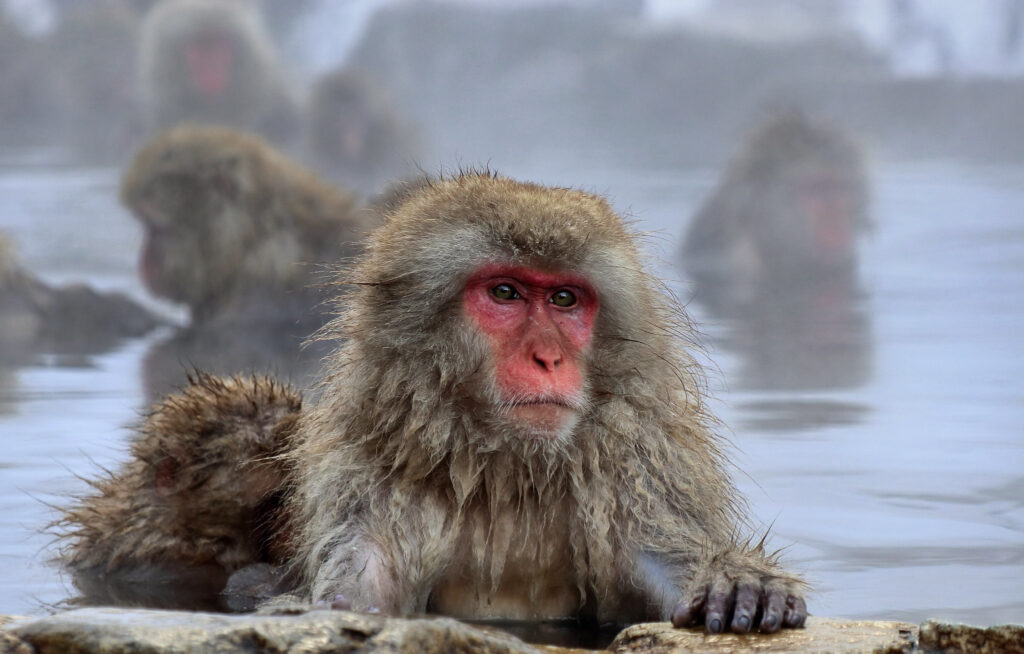
Known as the Valley of Hell because of its volcanic activity, the area is nowadays one of the main tourist centres in the region, as apart from the park itself there are villages such as Shibu, famous for its traditional baths or Onsen. The main attraction inside the park is to enjoy the daily scenes of the famous monkeys. At present the group of macaques consists of about 200 specimens. Apart from the bathing area of the macaques, another point of interest in the park is a small geyser that sprays water up to a height of more than 10 metres. The entrance fee to the park is 800 Yen per person.
2. Kanazawa, Ishikawa
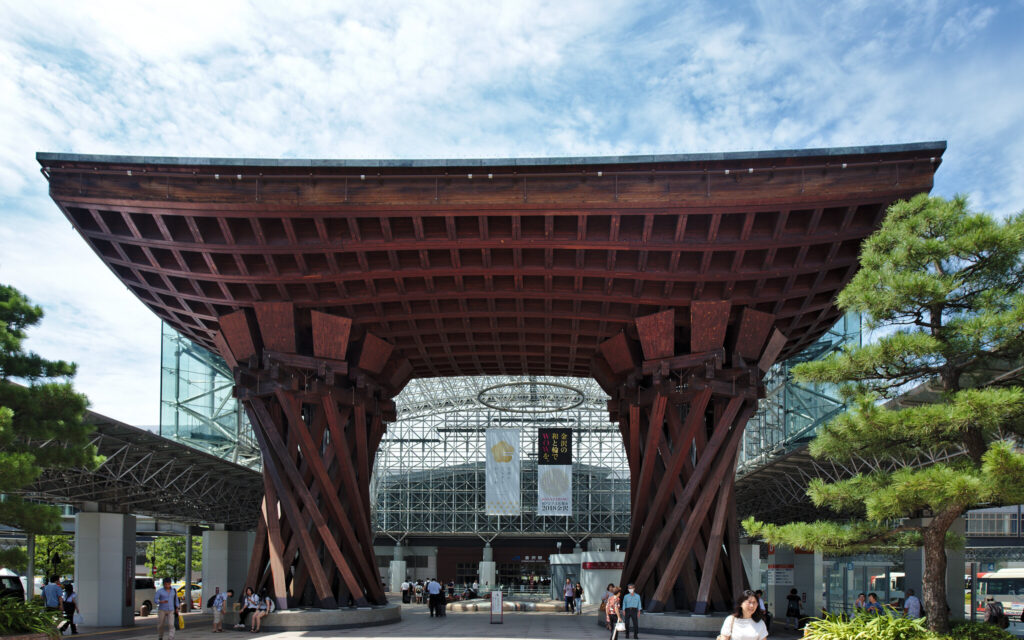
Kanazawa is a large but quiet city, famous for its castle, its geisha and ninja quarters and its large parks and gardens. Very close to the gardens is the famous and grand Ishikawa Gate which marks the entrance to the park of the old Kanazawa Castle of which several parts have been reconstructed. Being located next to the Kenrokuen Gardens, it is well worth a stroll, a break from sightseeing, or to sit and eat an onigiri and watch the time go by.
3. The Atsuta Shrine, Nagoya
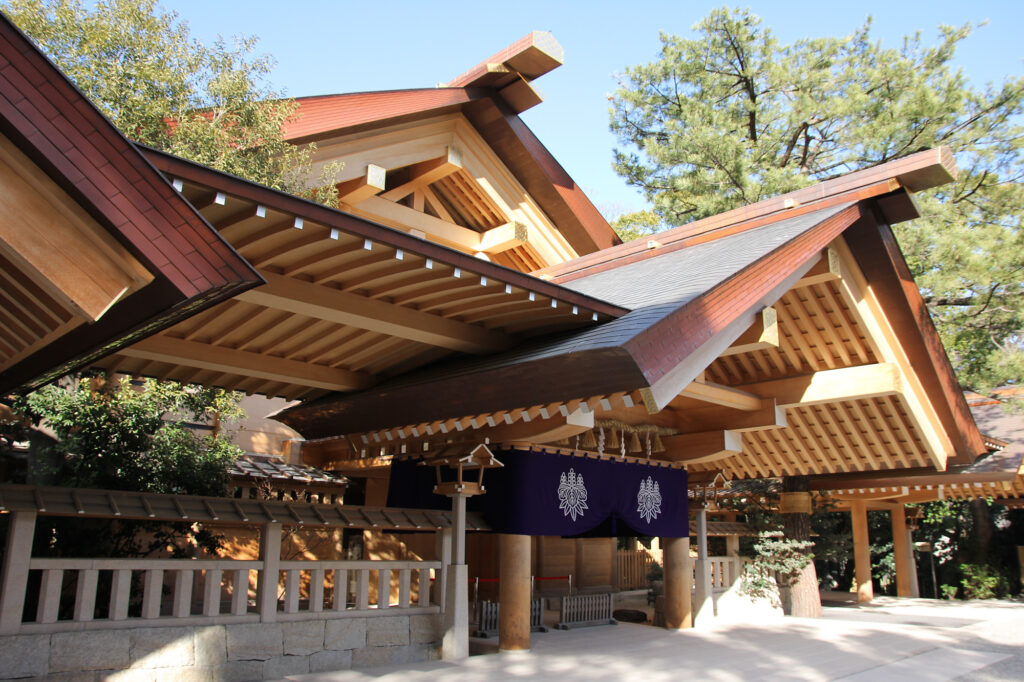
It is the second most important Shinto shrine in the country, after the Ise Grand Shrine. With a surface area of 200 000 m² and almost 2000 years old, the Atsuta Shrine is a real oasis of peace and tranquillity, a fantastic green lung in the heart of Nagoya. It is one of the most important Shinto shrines in Japan and worships the sun goddess Amaterasu Okami. Inside the shrine is the sacred sword Kusanagi, one of the three imperial treasures, but it is not on public display.
4. Matsumoto Castle, Nagano
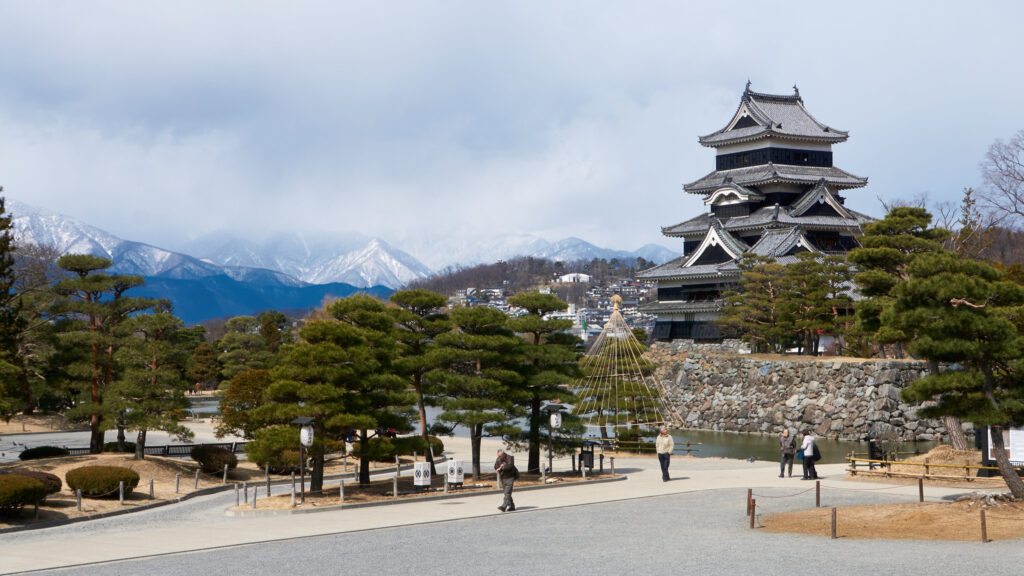
It is one of the most beautiful castles in Japan and one of the main tourist attractions in the city of Matsumoto. The construction is original and declared a National Treasure of Japan. The interior has hardly any furnishings or decoration. Some weapons from the time of the castle’s construction can be seen. A series of steep stairs leads to the top of the main tower. From there you can enjoy beautiful views of the mountains, the Japanese Alps and the city. It takes no more than 2-3 hours to visit the interior of the building and stroll around the photogenic surroundings.
5. Kenrokuen Garden, Kanazawa
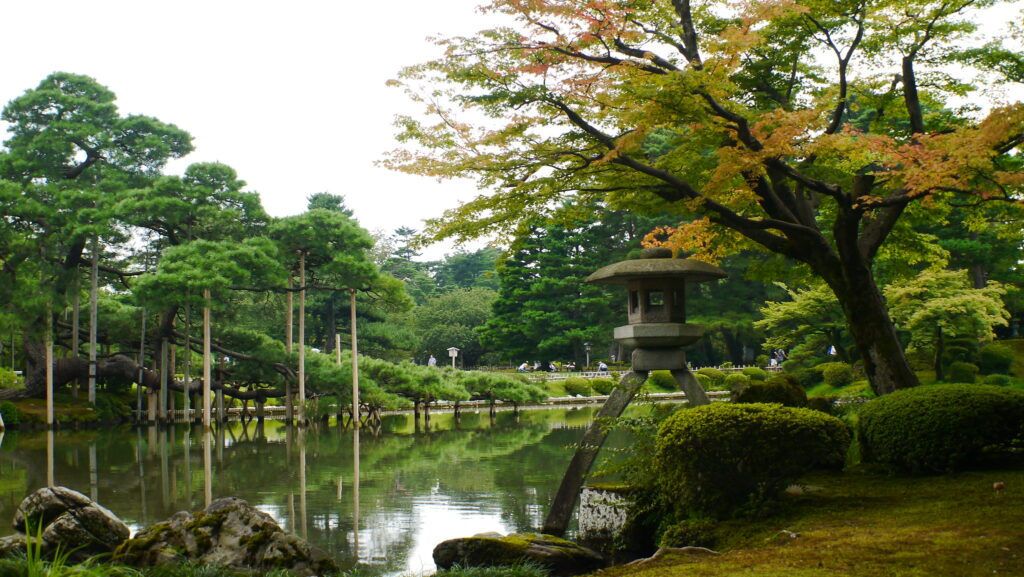
Kenrokuen is a Japanese-style garden outside Kanazawa Castle with the purpose of enjoying the four seasons in a place where you can take a relaxing stroll. In Kenrokuen Gardens there are about 160 different plant species and about 8200 trees. Of these, the most famous is the majestic Karasaki pine. There are also teahouses in the garden where visitors can sip tea and eat traditional Japanese sweets while gazing at the scenery.
6. Shirakawa-go, Ōno
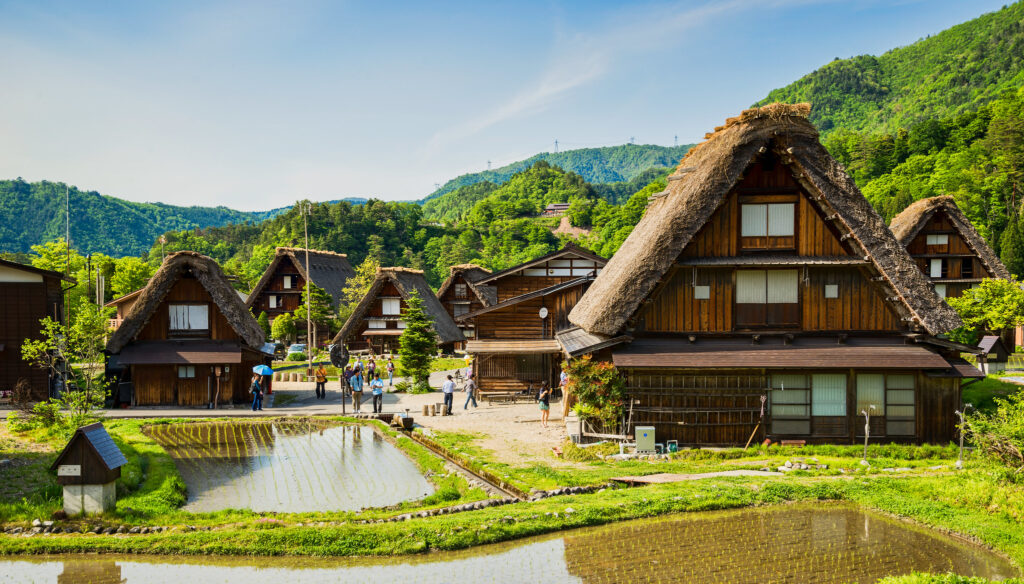
The beauty of the surroundings and its famous traditional houses have made this village one of those must-see places for every traveller in Japan. The main feature of Shirakawa-go is its gassho-zukuri style houses, large houses with triangular roofs, where thatch replaces tiles. This is a historic village where some of the houses are more than 250 years old and of course many of them can be visited. In fact some of them are house museums. Many of the traditional houses are minshuku, family lodgings, or ryokan, traditional Japanese inns. They usually offer accommodation as well as dinner and breakfast.
7. Shira-Ito Waterfall, Shizuoka
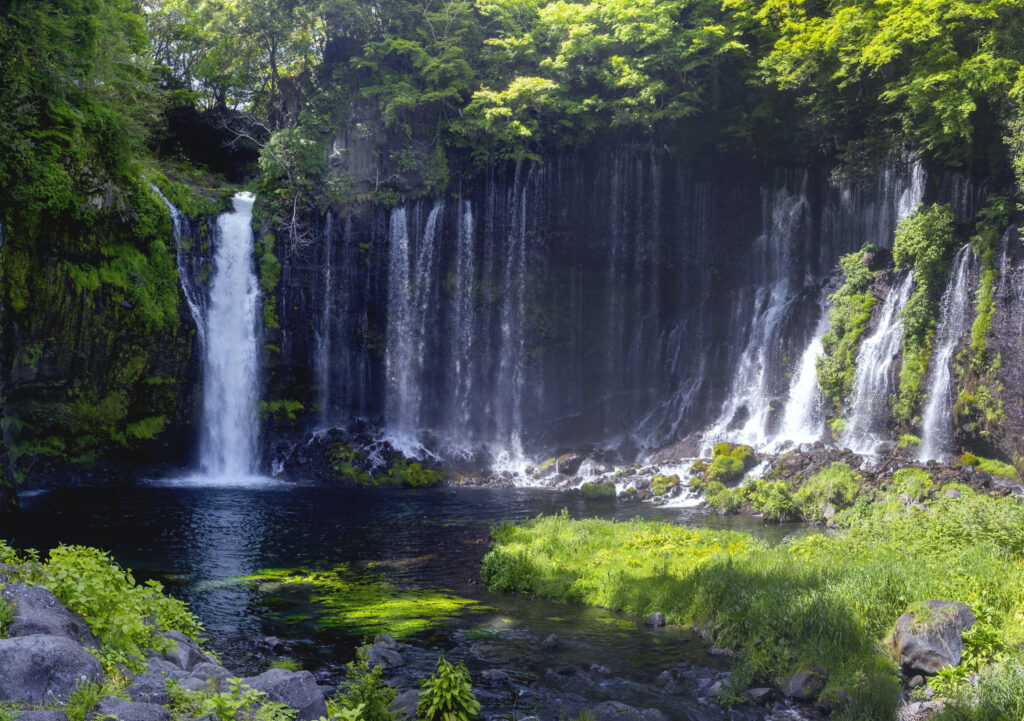
Three metres high and 70 metres wide, it is surrounded by spectacular nature and forms a beautiful curtain of water. The waterfalls are well worth a visit to see the crystal-clear waters pouring over a turquoise background. Shiraito Falls was named one of the “100 best waterfalls” in Japan by the Japanese Ministry of Environment. The area is especially beautiful in summer when the waterfalls are bathed by melting snow from Mount Fuji.
The Best Places in Chūgoku
8. Hiroshima Peace Memorial Park, Hiroshima

The so-called Peace Memorial Park, built as a memorial park and peace memorial in 1948, is located in the city of Hiroshima and consists of more than 120,000 m2 of trees, lakes and paths. The park has more than 60 points and monuments, including the Genbaku Dome, the Children’s Peace Memorial, the Peace Museum and the Peace Flame, which will only be extinguished when all nuclear weapons have been eliminated from the planet. Every year, on the anniversary of the bombing, a ceremony is held in the park.
9. Itsukushima-Jinja gate, Hiroshima
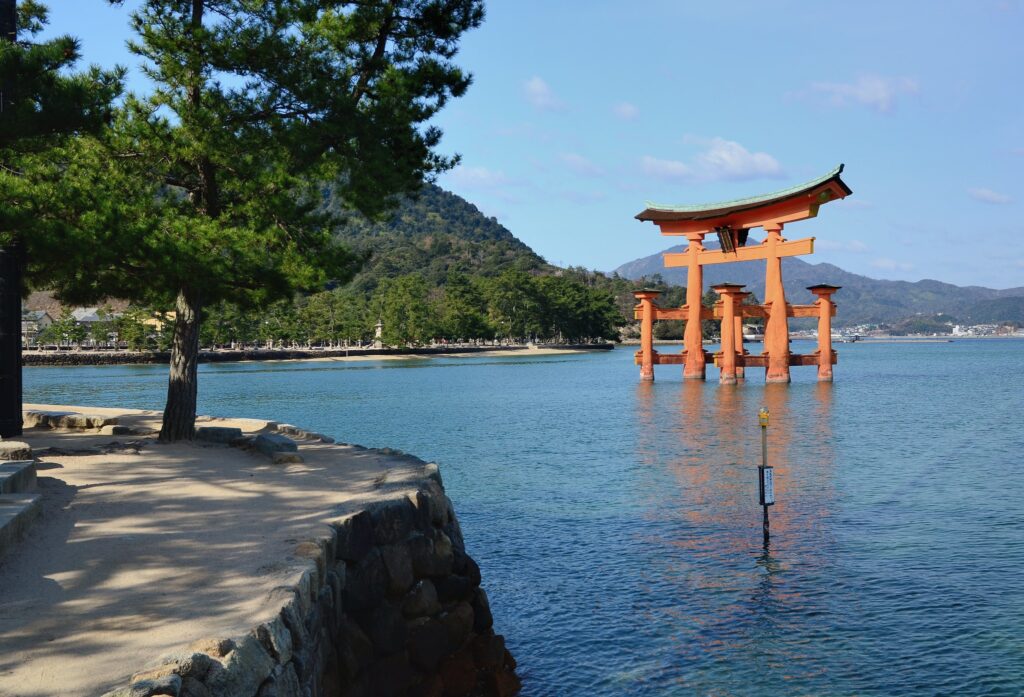
It is one of the most famous shrines among tourists travelling to Japan. It is undoubtedly the main tourist attraction on the island of Miyajima. A shrine that is also a World Heritage Site and one of the three most beautiful landscapes in the country as it is one of the most beautiful and best preserved in Japan. It is also a beautiful example of traditional architecture in a wonderful natural environment such as Miyajima Island.
The Best Places in Hokkaidō
10. Mount Fuji, Honshū
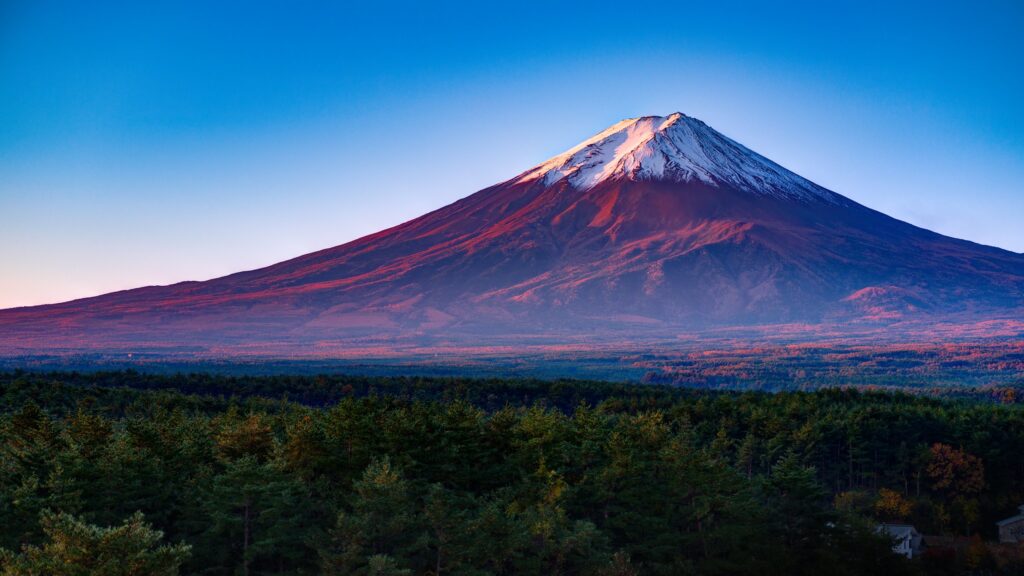
Mount Fuji, with its imposing 3776 metres, is Japan’s highest and most beloved mountain and has been a World Heritage Site since 2013. It is a volcano that is still active, and in its own right, with no other mountains around it, it is awe-inspiring. Although the routes to Mount Fuji are only open in July and August, in summer it is very difficult to see or photograph Mount Fuji, because it is usually hidden behind a curtain of clouds of heat and humidity. In winter, on the other hand, the air is usually cleaner and clearer, so Mount Fuji is usually quite visible. The winter months are most likely to be a good time to take a chance and get up close to Mount Fuji to see it.
11. Chūbu-Sangaku National Park, Honshu
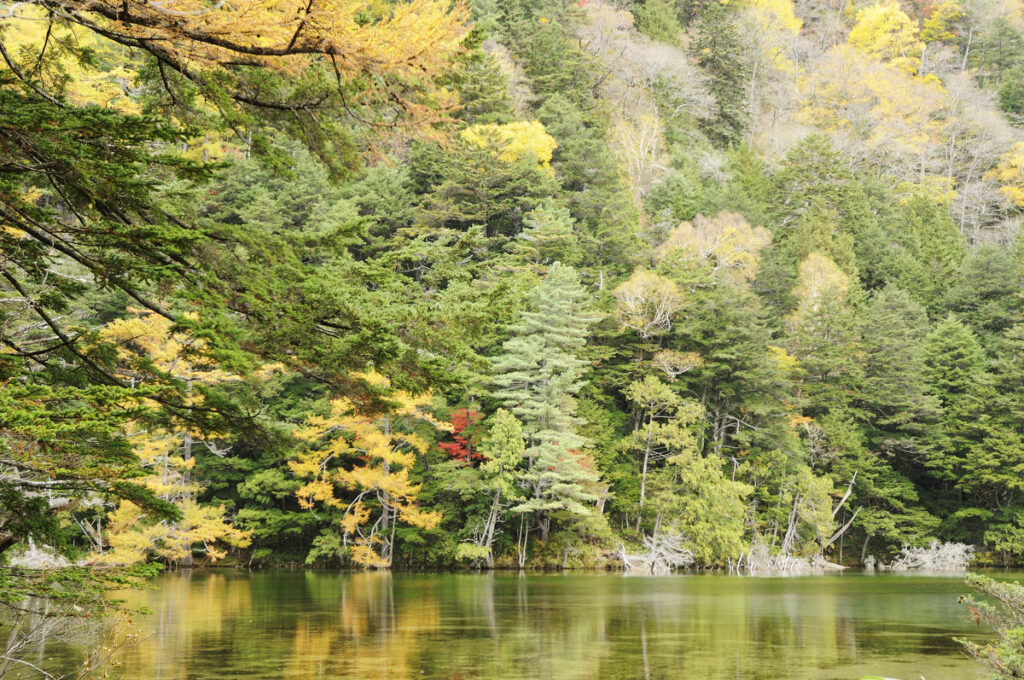
Located in the Northern Alps of Japan, the Azusa River meanders through the valley. It is a beautiful place all year round, from the first buds in early spring to the magnificent colours of the autumn leaves. Kamikochi is a 15 km plateau along the Azusa River, 1,500 metres above sea level. It is a fantastic hiking area with easy, flat trails along the valley floor from Taisho Pond to Myojin Bridge.
12. Shirogane Blue Pond, Hokkaido
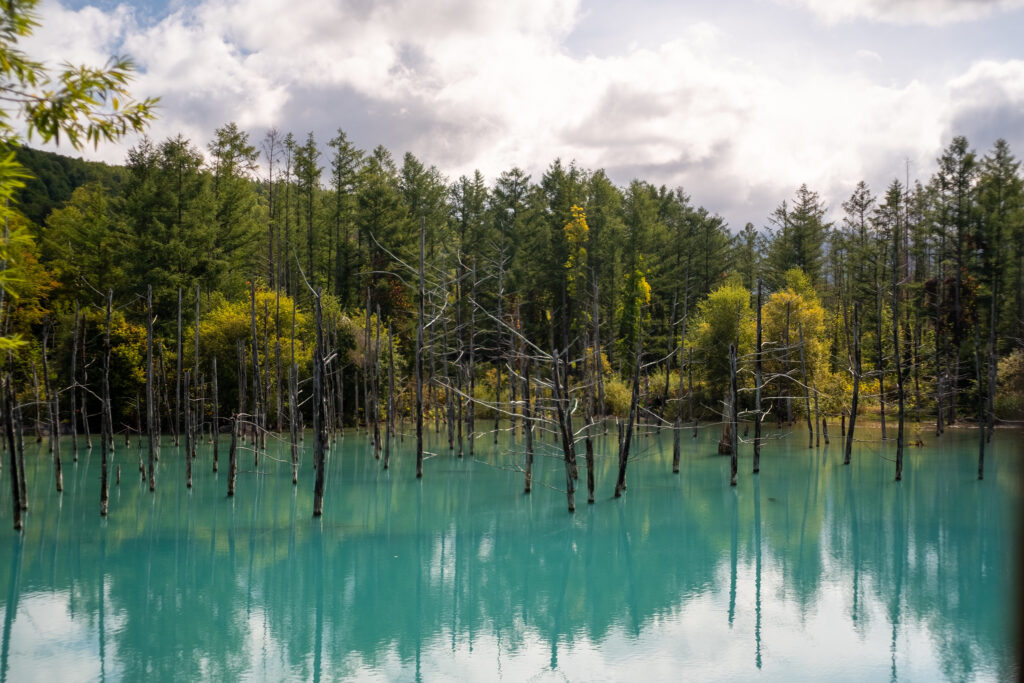
Blue Pond is a man-made reservoir in Biei, Hokkaido, which is supposed to protect the city from mudflows. It is famous for its colour due to a certain amount of colloidal aluminium hydroxide in the water. It looks quite impressive in the summer as well, but the real magic of this place reveals itself only during the cold season. During the winter months, the nights have a fairytale atmosphere as the Blue Pond area is illuminated. Some travellers and photographers love it, as the lights constantly change colour.
13. Akan Mashu National Park, Hokkaido
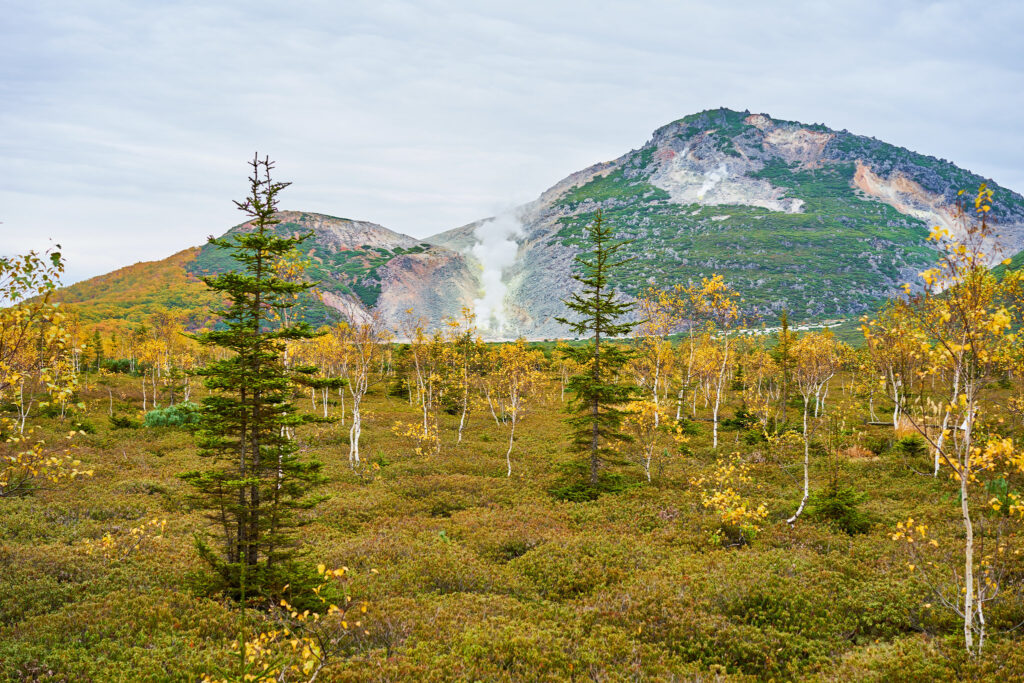
Akan Mashu National Park is located in the north of the island of Hokkaido and is known for its unspoilt beauty, active volcanoes and crystal clear crater lakes. The most famous is Lake Mashu, one of the most beautiful lakes in Japan. The water here is one of the clearest in the country. Many visitors prefer to stay in the small town of Akanko, located south of Lake Akan. Here you can cruise the lake, famous for its unique spherical “marimo” seaweed, or climb one of the two mountains in the area, Oakan and Meakan, both ancient volcanoes. They are not difficult to climb, but June to October is the best season.
The Best Places in Kansai
14. Arashiyama’s Bamboo Grove, Kyoto
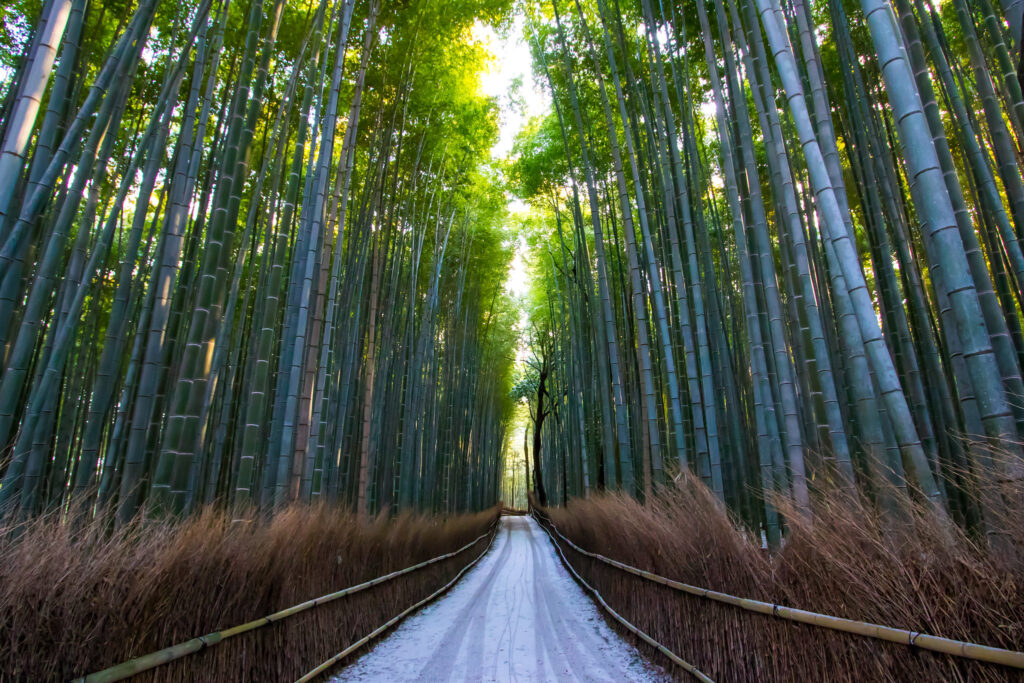
It is a beautiful tourist destination west of the city of Kyoto, especially known for its beautiful bamboo forest. However, Arashiyama offers many more options for sightseeing, leisure and entertainment. From seeing macaques in semi-freedom to taking a boat ride or enjoying a rickshaw tour, Arashiyama is open 24 hours a day, 7 days a week. The forest is open 24 hours a day, every day of the year. The momiji festival in Arashiyama is held on the second Sunday in November, and is a favourite with many visitors because of the colourful red autumn leaves in the landscape. In addition, there are plenty of traditional dance and music performances, performers dressed in traditional Heian-period costumes and street food stalls.
15. Daibutsu (Great Buddha) of Nara, Nara
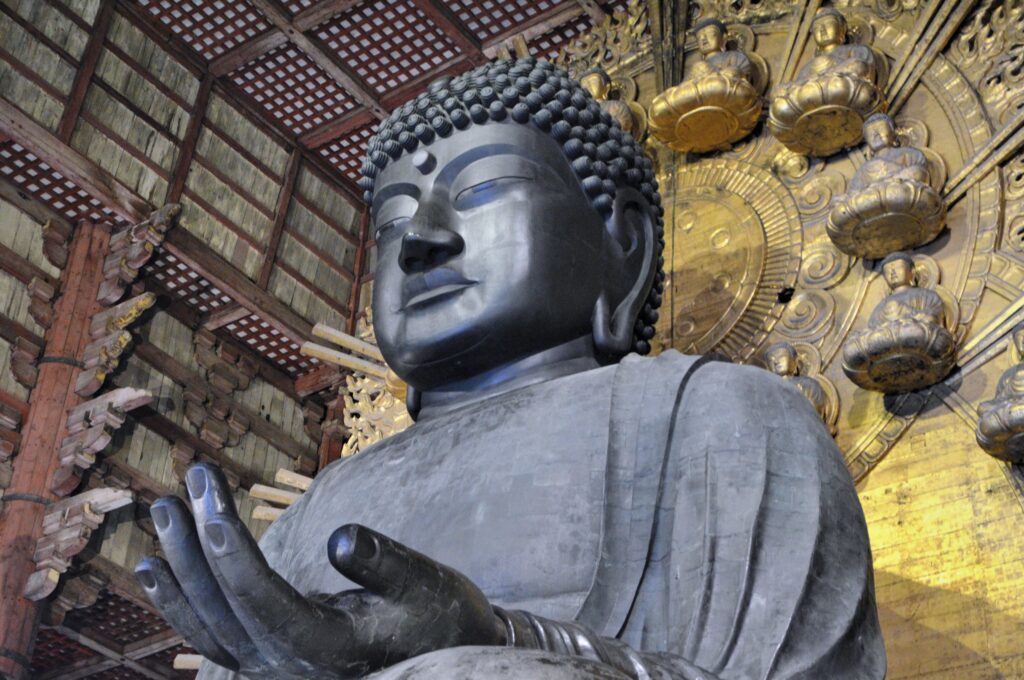
It is a Buddhist temple located in the city of Nara, 42 kilometres from Kyoto. Despite being over 1,250 years old, it holds the Guinness World Record for being the largest wooden building in the world. Its spectacular nature makes a visit to this temple alone worth your time in Nara. The first thing you notice when you enter is the bronze statue of the great Buddha Daibutsu. It is a sitting Buddha statue, 16 metres high and weighing 500 tons. Parts of its construction are carved in gold. Just behind it are two Bodhisattvas almost as big. It is free to enter the grounds to see the building from the outside, but to enter the large pavilion you have to pay 600 yen.
16. Gion District, Kyoto
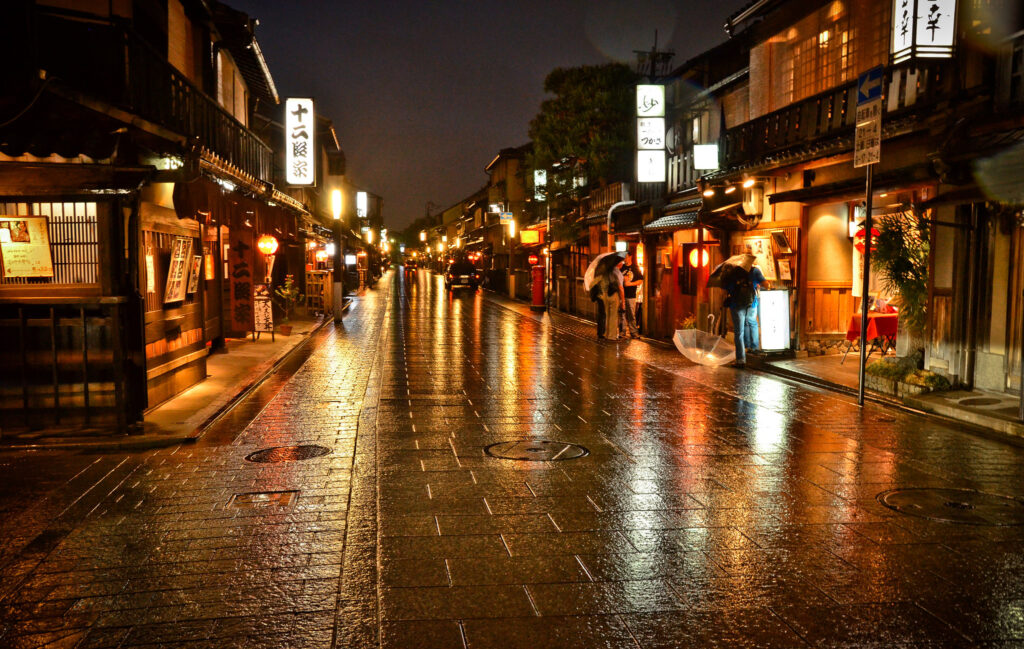
In the ancient capital of Japan, you can feel the true Japanese spirit that endures through time, originally created to serve as a resting place for those who went to pray at the Yasaka shrine, which is located in the same area. Gradually this place evolved into a place for the entertainment of samurai, important people and businessmen. Gion is the place where the famous geisha, the cultural symbol of the nation of the rising sun, make their home. In Gion there are several districts called hanamachi which literally means flower city and is where the okiya and ochaya meet. They should not be stopped for a photo, touched or approached inappropriately. If you are lucky enough to come across one of them, you can take pictures from a safe distance and be glad to have seen it.
17. Himeji Castle, Himeji
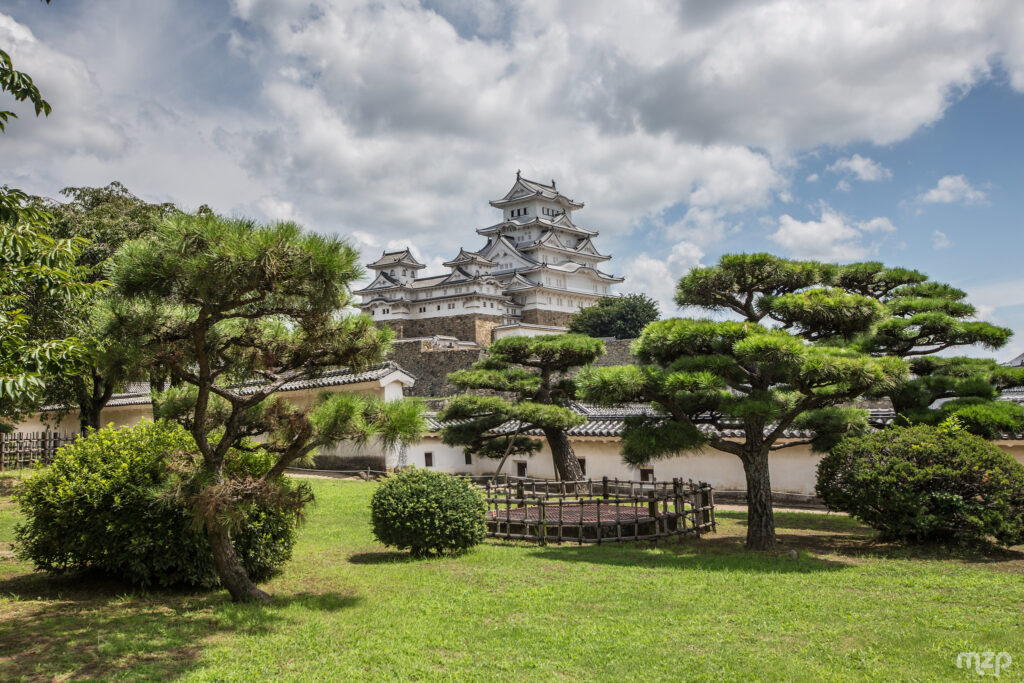
Also known as “White Heron Castle”, it is one of the most spectacular castles in Japan, one of those castles that is worth seeing in person. Its white walls, its architecture, its winding paths… All this makes this castle a must-see in Japan. It is truly impressive not only for its size, but also for its architectural structure. But it is also impressive on the inside, because as we explained a few lines above, it has many corridors. It is labyrinthine and has a multitude of secret rooms. And as you go up, the stairs get narrower and narrower and steeper and steeper.
18. Kõya-san, Wakayama
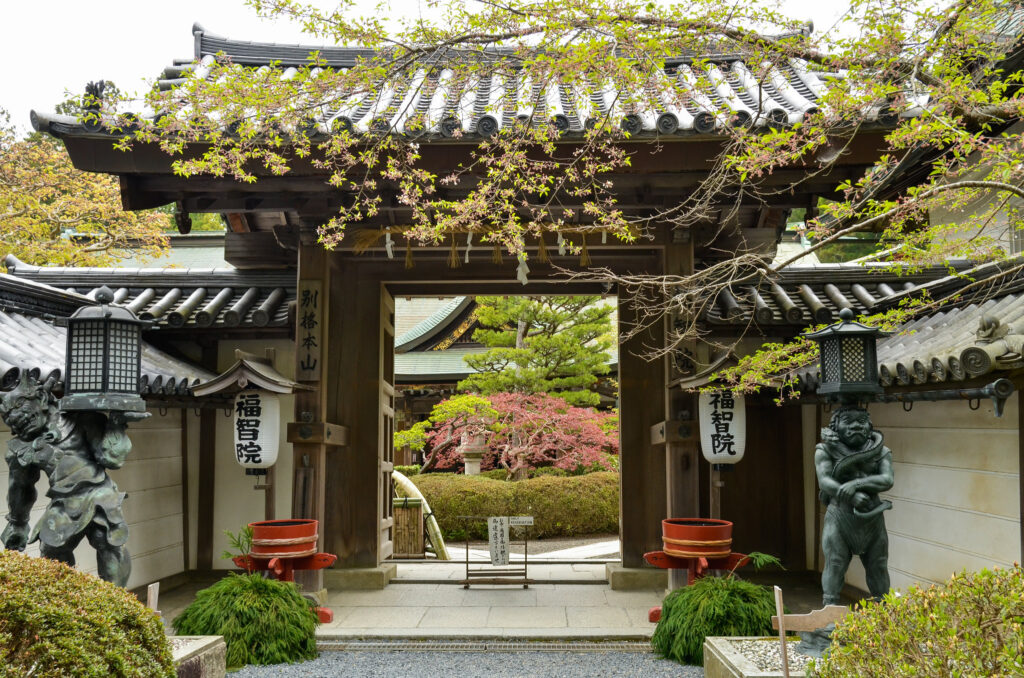
It is the nerve centre of Shingon Buddhism, one of the most important Buddhist schools in the country. This school was brought to Japan by Kobo Daishi more than 1200 years ago, one of the leading figures of Japanese Buddhism. It has become one of Japan’s most popular pilgrimage destinations, attracting more and more Japanese and foreign visitors every day. The scenery, the temples, the spirituality and, above all, sleeping in a Buddhist temple while visiting the area has a special charm.
19. Kofuku-ji Temple, Nara
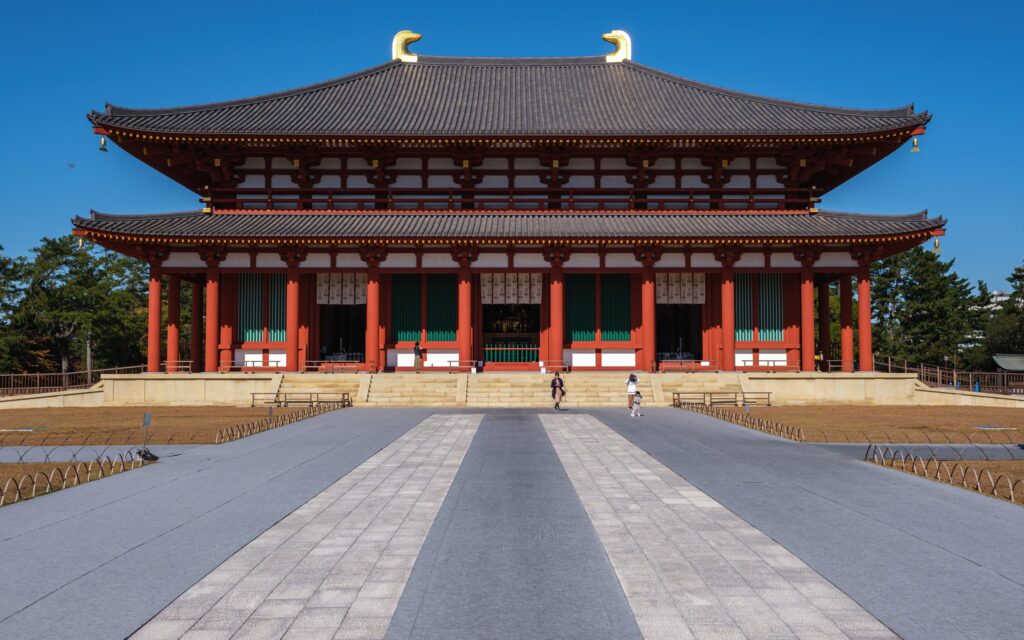
The Kofukuji Temple is the first temple you see when you enter the Nara Koen Nature Park, with its spectacular tower that dominates the sky over the grounds. Especially visible are its famous three- and five-storey pagodas, which are the main attraction of this sanctuary and one of the park’s great icons. The temple has several buildings worth visiting, such as the Tokondo Hall, and the National Treasures Hall, where art objects and statues from various periods are on display. The temple leads to the large Nara Koen Park, which contains most of the treasures of the ancient capital. It is very easy to get around the park and find the places described here as there are signs in English indicating the direction to follow.
20. Nijo Castle, Kyoto
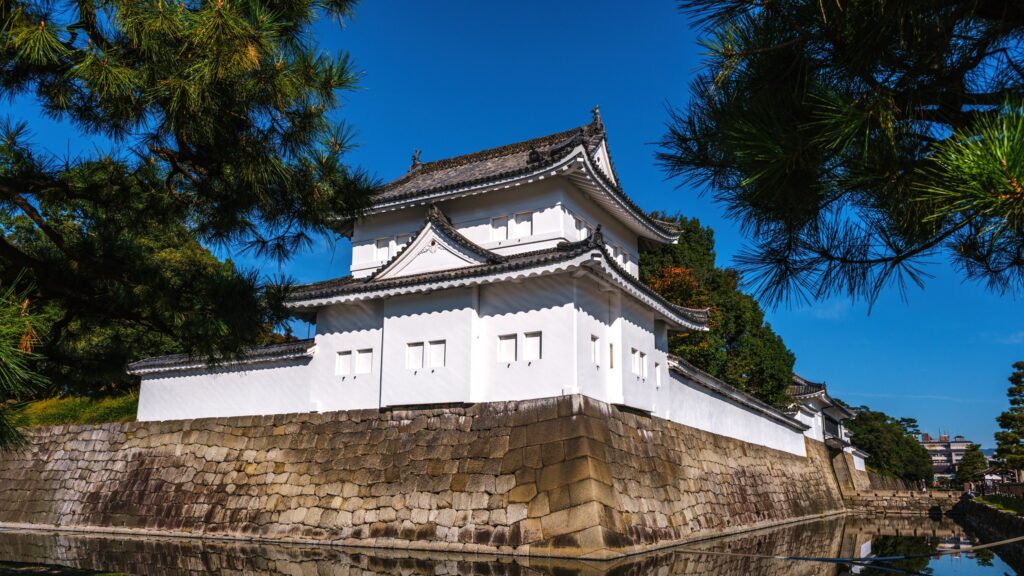
Literally “castle on street two”, it is one of the most spectacular buildings in Kyoto and a perfect example of the palatial castle architecture of Edo-period Japan. The main entrance to Nijo Castle is to the east, from where we enter the impressive Karamon Gate, which was under renovation until recently. This leads to the entrance of Ninomaru Palace, where the shogun’s residence and offices were located during his visits to Kyoto. The gardens surrounding the Ninomaru and Honmaru palaces have many different species of trees, making the visit perfect almost any time of the year.
21. Kyoto Imperial Palace, Kyoto
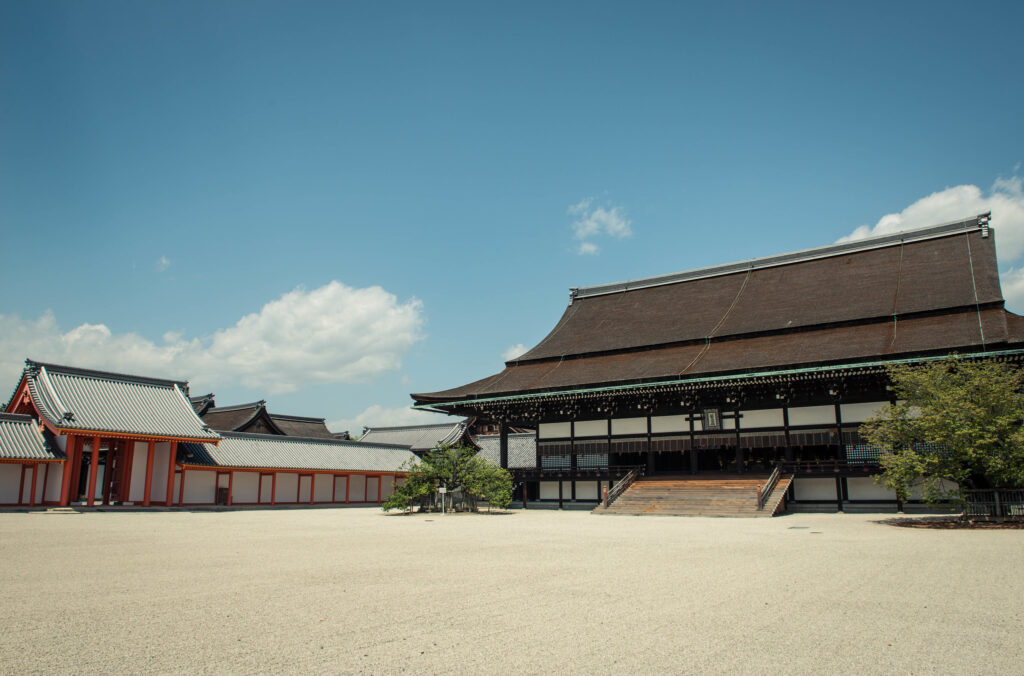
The Kyoto Imperial Palace is a must-see place to visit in Japan. The palace used to be the residence of the Imperial Family of Japan until 1868 when the emperor and the capital moved from Kyoto to Tokyo. The palace can only be visited on guided tours by the Imperial Agency. Interested parties must register in advance with their passport at the agency’s office in Kyoto’s Imperial Park. Guided tours can also be booked online.
22. Osaka Castle, Osaka
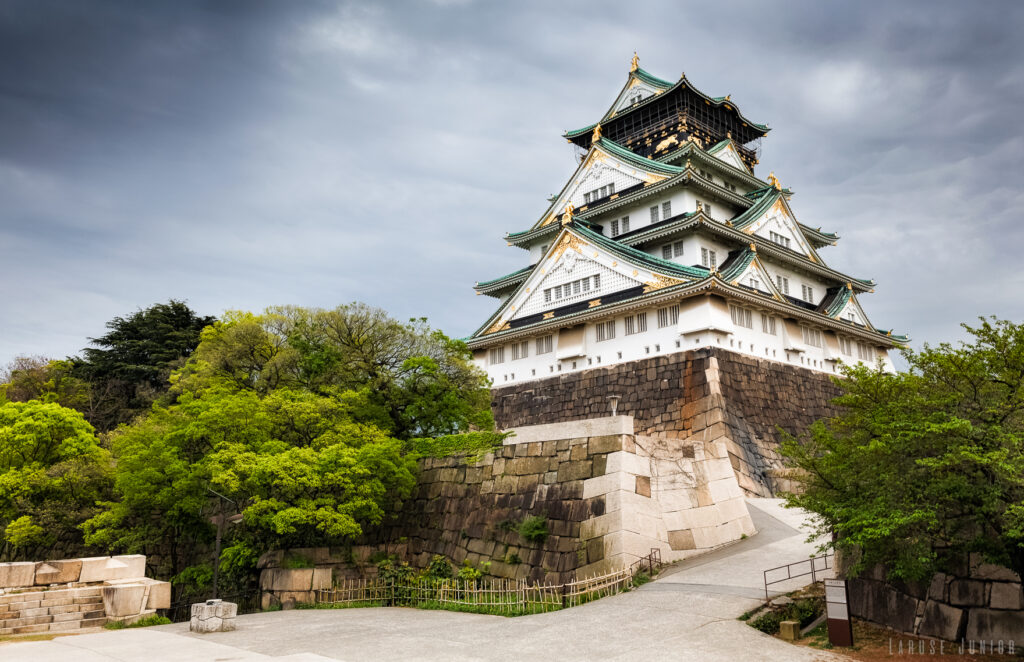
Osaka Castle is one of the most famous and visited places in the city. It has a long and interesting history. The area around the tower has been developed as a park, and the plum, cherry blossom trees in spring and red leaves in autumn offer magnificent views. When you enter the extensive grounds, you feel as if you are stepping back in time to the Sengoku era. An observation deck surrounds the eighth floor, from where you can enjoy a panoramic view of Osaka and its surroundings. Visitors usually climb up to this platform first and use the stairs to descend to the lower levels of the tower.
23. Hokoku Shrine, Osaka
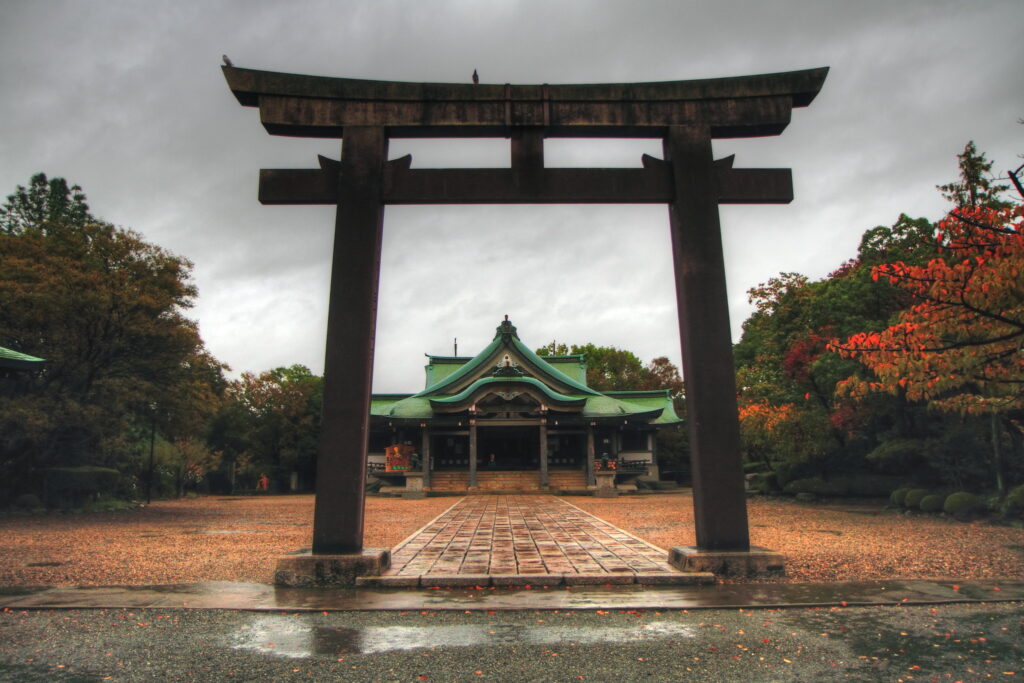
Hōkoku-ji temple in Kamakura was built in 1334. It belongs to the Rinzai school of Zen Buddhism and was the family temple of two samurai clans, the Ashikaga and the Uesugi. Its popularity comes from the fact that it houses one of the best bamboo forests in Japan, with more than two thousand plants spread over an area of around 2,000 square metres. Usually, in the Shinto shrine, the gods that appear in Japanese mythology or legendary gods are worshipped.
24. Shitennō-ji, Osaka
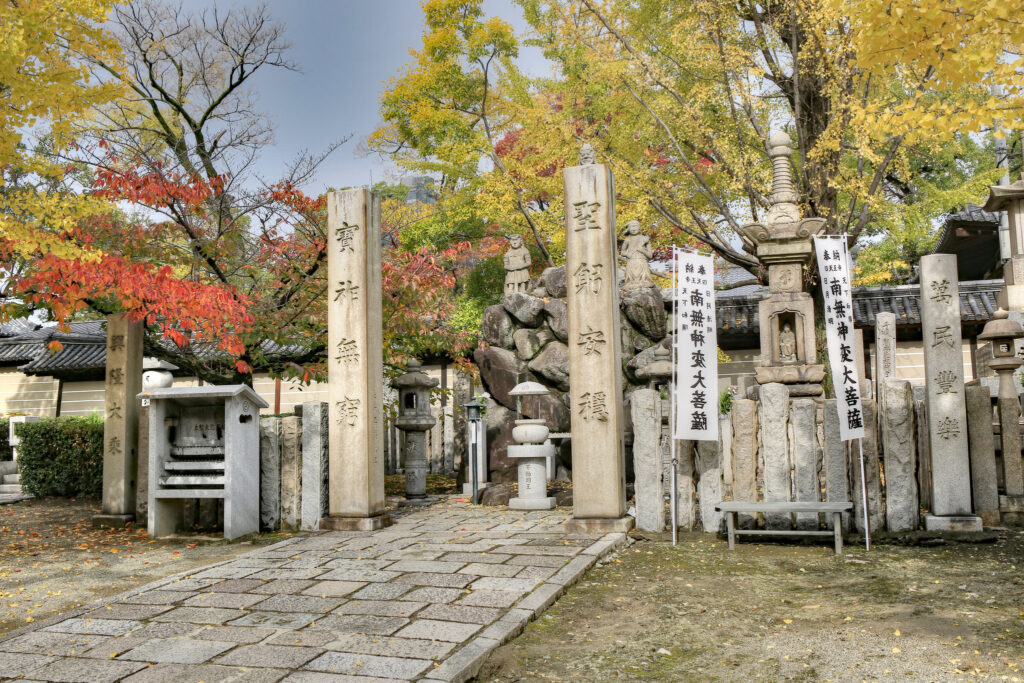
It is the oldest Buddhist temple in Japan, more than 1,400 years old. However, the structure we can see today dates back to 1963, when the temple was rebuilt. Shitennoji is one of the most visited places in Osaka by tourists. In the inner area you can see noble buildings such as the Main Hall, the Conference Hall or the spectacular 5-storey pagoda, while in the outer area is where we find the beautiful Gokuraku-jodo garden. Here you will find the Treasure House (with objects considered as national treasures of Japan) and the Prayer Hall. In addition, there are some beautiful gardens.
25. Kinkaku-ji, Kyoto
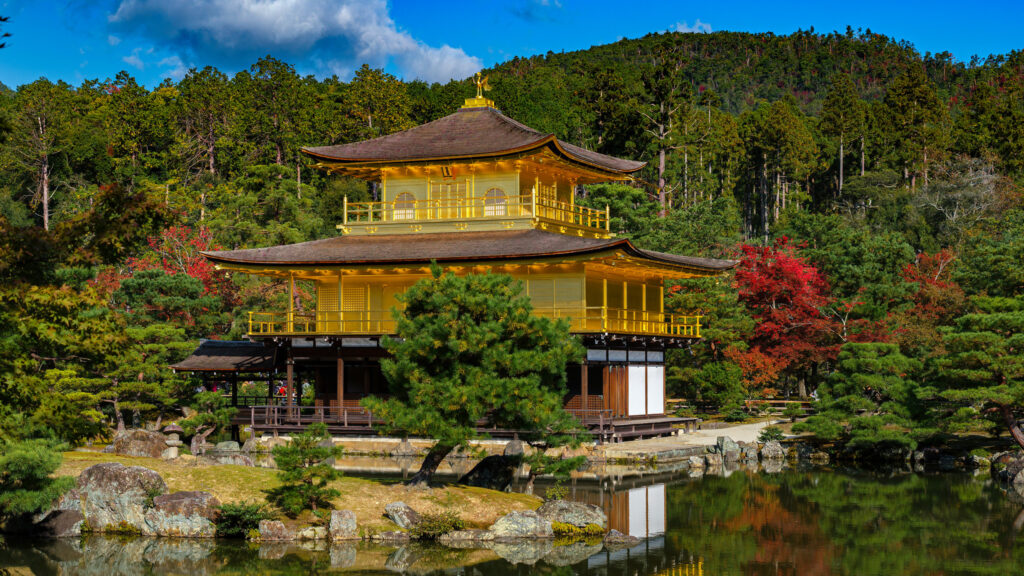
It is the temple that attracts the most visitors and a tourist attraction due to its postcard photo with the golden colour of the pavilion and its reflections in the pond. It is a beautiful place, although there is not much else to see and it is somewhat remote, north of Kyoto, but it is an essential stop for any tourist on a tour of Kyoto. It has also been a UNESCO World Heritage Site since 1994 and is part of the Historic Monuments of Ancient Kyoto.
26. Moss Garden of Saiho-ji, Kyoto
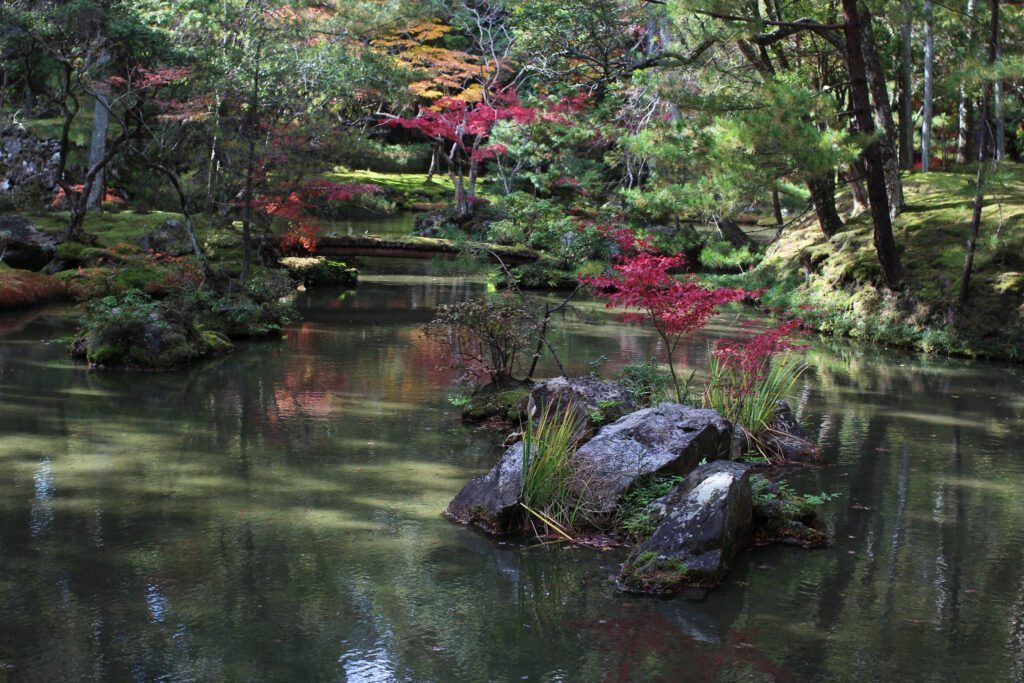
The temple is a must for garden lovers. Particularly beautiful in the rainy months (June and September), the velvety carpet of moss stretching between the trees is a vision of tranquillity. There are thought to be around 120 varieties of moss in the garden, in all shades of green. The garden is divided into two halves, including a classic kokoro heart-shaped pond and a raked gravel landscape believed to be the first of its kind and the inspiration for many Japanese gardens.
27. Fushimi Inari-taisha Shrine, Kyoto
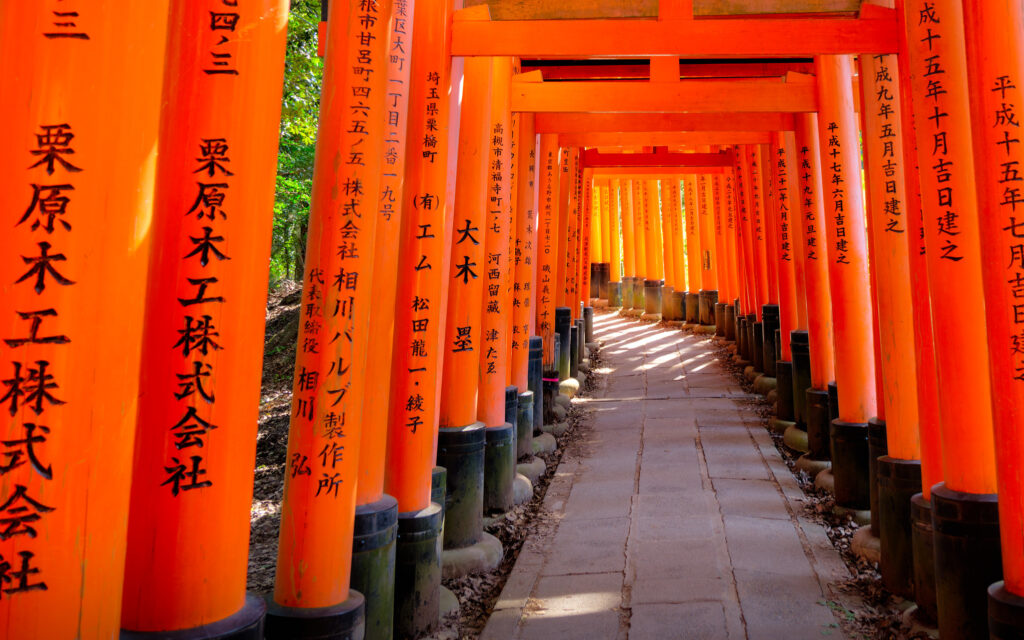
It is one of the best known and most important shrines in Japan. It is also one of the oldest, the main shrine dedicated to the deity Inari, of the 32,000 or so shrines in Japan dedicated to this god. The arc of vibrant orange torii gates, which becomes almost endless on its way to the top of Mount Inari, makes it a place of breathtaking beauty and one of Japan’s most famous images. It’s also open 24 hours a day, making it perfect for compact or hard-to-square itineraries.
28. Kiyomizu-Dera, Kyoto
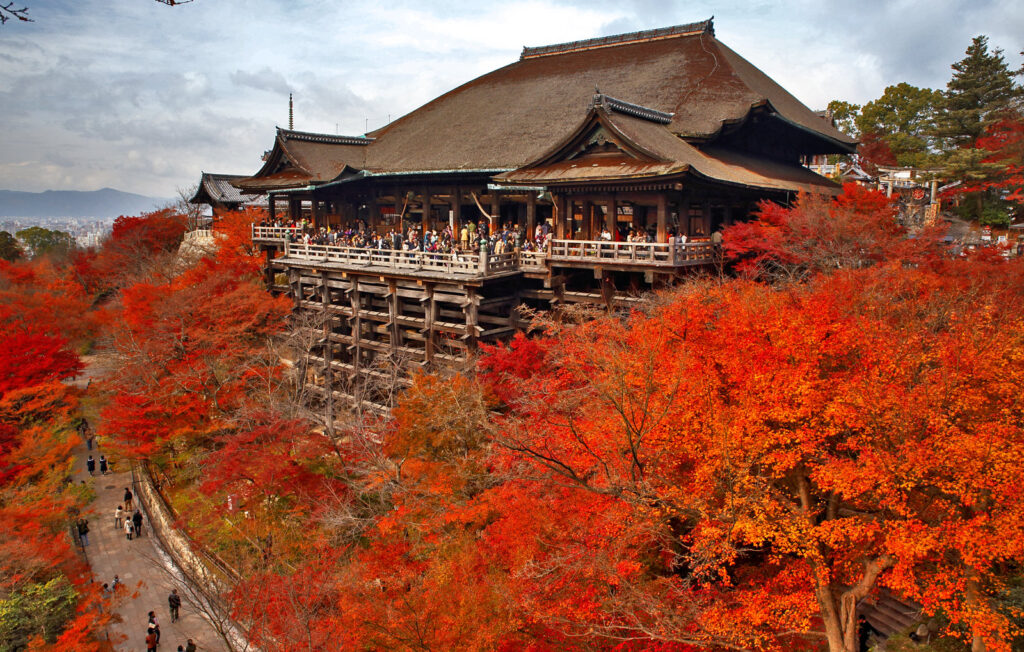
Meaning “temple of pure water” in Japanese, it was built in 778 in the hills east of Kyoto, on the site of the Otowa waterfall. The building juts out from the hillside and offers visitors spectacular views of the city. Water plays an important role in the temple, as several of the temple’s halls and buildings feature the liquid element as a symbol of purity and prosperity. Admission costs 400 yen and the design of the paper ticket varies according to the season, so many people try to go at least once every season to collect the different tickets.
29. Arashiyama Monkey Park, Kyoto
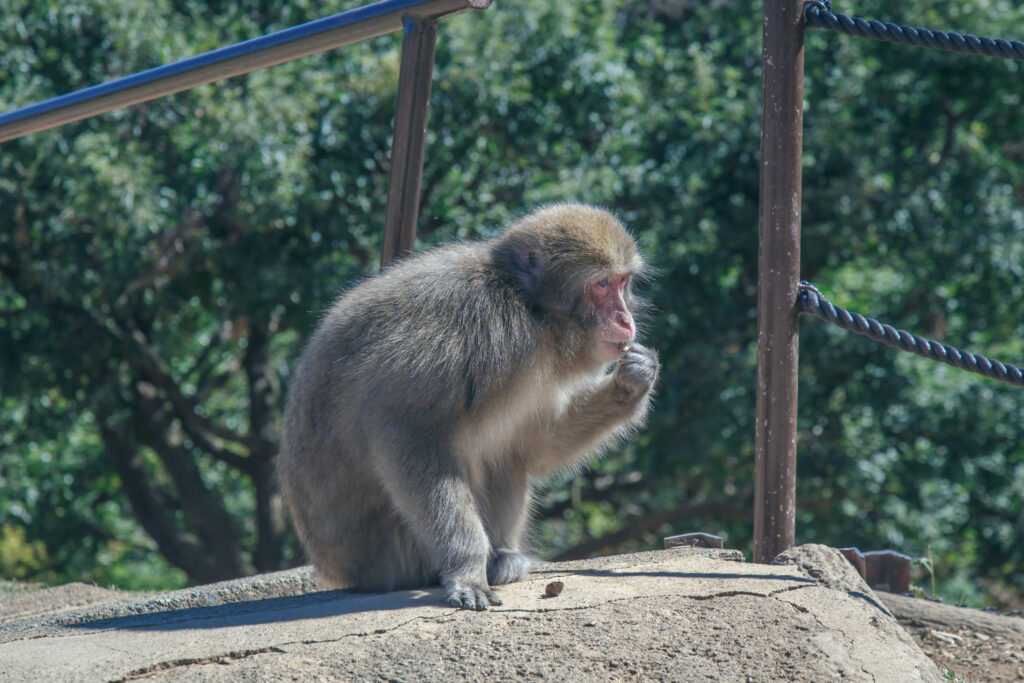
Located on the outskirts of the city, Arashiyama is one of Kyoto’s most famous districts in recent times. It has about 200 macaques in a state of semi-freedom. In addition to the experience of being surrounded by Japanese monkeys, at the highest point of the park there is a lookout point with an exceptional view. It is impossible not to come across smiles and laughter from both humans and monkeys as evidence that they are having a great time under the Kyoto sun. You can’t miss the opportunity to get so close to nature in Japan.
30. Dōtonbori, Osaka

A popular neighbourhood mainly because of its neon lights, the decorations on the facades of its many restaurants of all kinds and its great nightlife. It is Osaka’s entertainment district par excellence. It roughly consists of the streets between the Dotonbori and Aiai bridges south of the Dotonbori Canal. The canal was completed in 1615 with the intention of connecting the Umezu and Yokobori rivers to boost trade in the area. If you are not walking from other parts of Osaka, the best way to get there is underground, as Namba station is within walking distance.
31. Nara Park, Nara
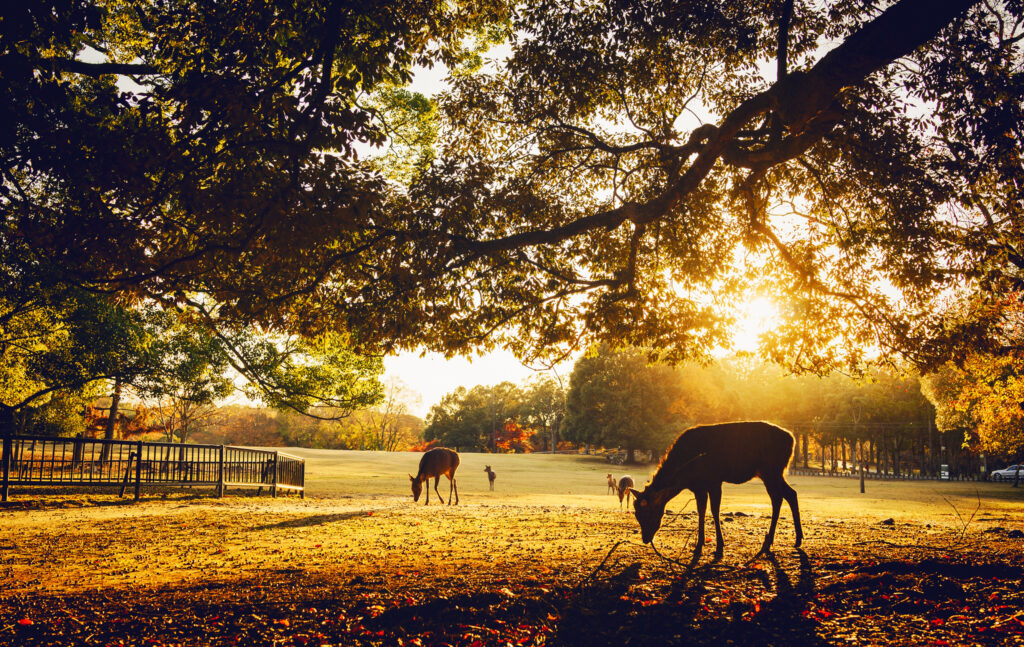
It is a large park located in the centre of the city. It was established in 1880 and is where you will find most of Nara’s attractions including Todaiji Temple, Kasuga Taisha Shrine, Kofukuji Temple and the Nara National Museum. Nara Park is home to hundreds of deer or Shika that roam freely in the open air. In Shinto, they are considered messengers of God, and some 1,200 deer live in Nara, which is why they have been designated as natural treasures.
32. Universal Studios Japan, Osaka
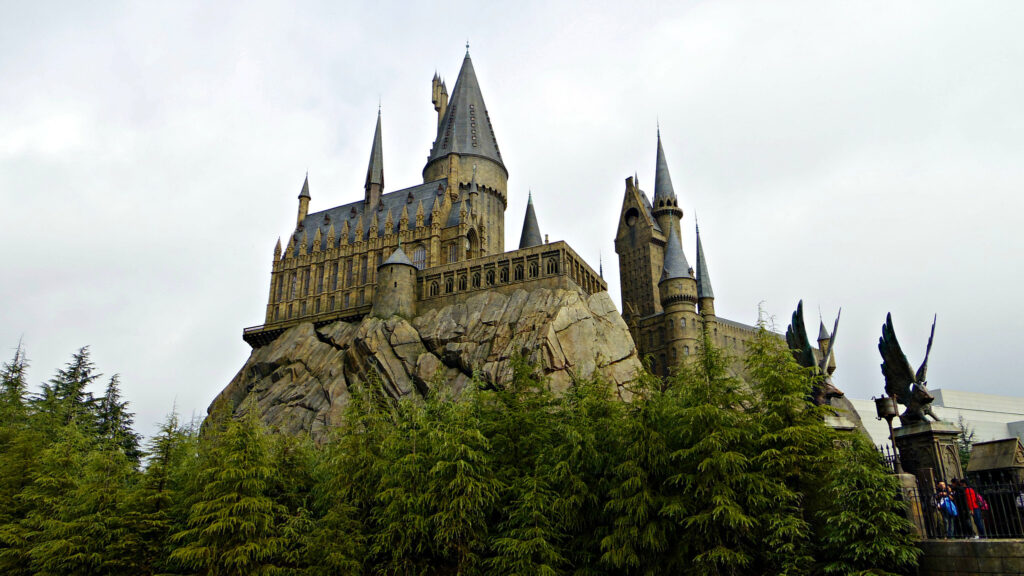
It is a Universal theme park that opened in March 2001 in the Osaka Bay area. Today, more than ever, it is a theme park for the whole family, with a Harry Potter-themed area as one of its main attractions. As in any theme park of this kind, visitors can go on a host of rides, from the most child-friendly and family-friendly to the most modern simulators of classic films such as Spiderman or Back to the Future, take photos with the mascots that roam around the park, watch different street shows or enjoy the night-time parade.
33. Tōdai-ji, Nara
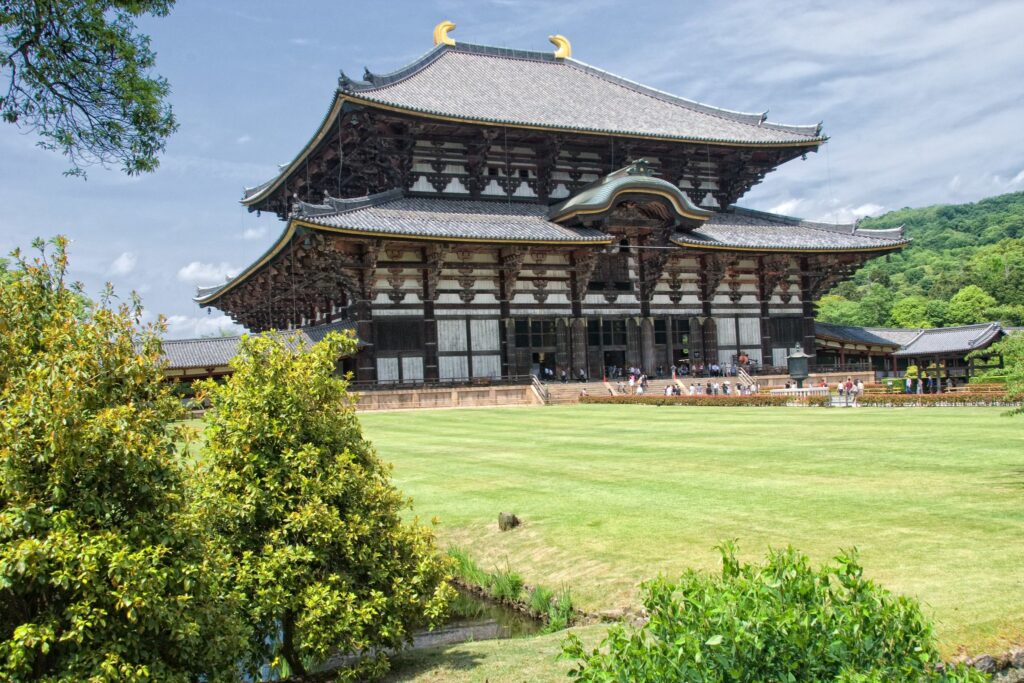
The visit to the temple begins at the Nandaimon gate, a large 20-metre wooden gate sheltered on both sides, as is usual for such gates, by two Nio guardians, two statues that together with the gate. The gate is usually well accompanied by a lot of sika deer and on the way we can buy sembei rice crackers for them. After passing through the gate, we enter the Daibutsuden Hall complex, the main hall of Todaiji Temple. One of the most attractive places for tourists is the pillar with a hole the size of the Big Buddha’s nostril. Tourists, big and small, queue up to try to pass through the hole because it is believed that if you can pass through it, you will achieve enlightenment in the next life.
34. Osaka Aquarium Kaiyukan, Osaka

This aquarium is one of the most spectacular in the country. It features marine species in 15 tanks, each representing a region of the Pacific Ocean. The main attraction of the Osaka Aquarium is a whale shark, which is housed in the central tank. Visitors begin their tour of the Osaka Aquarium on the eighth floor and spiral down floor by floor around the main tank. Some of the tanks are several storeys high so that the species living in them can be observed from different depths and perspectives.
The Best Places in Kantō
35. Hot Springs, Kanagawa
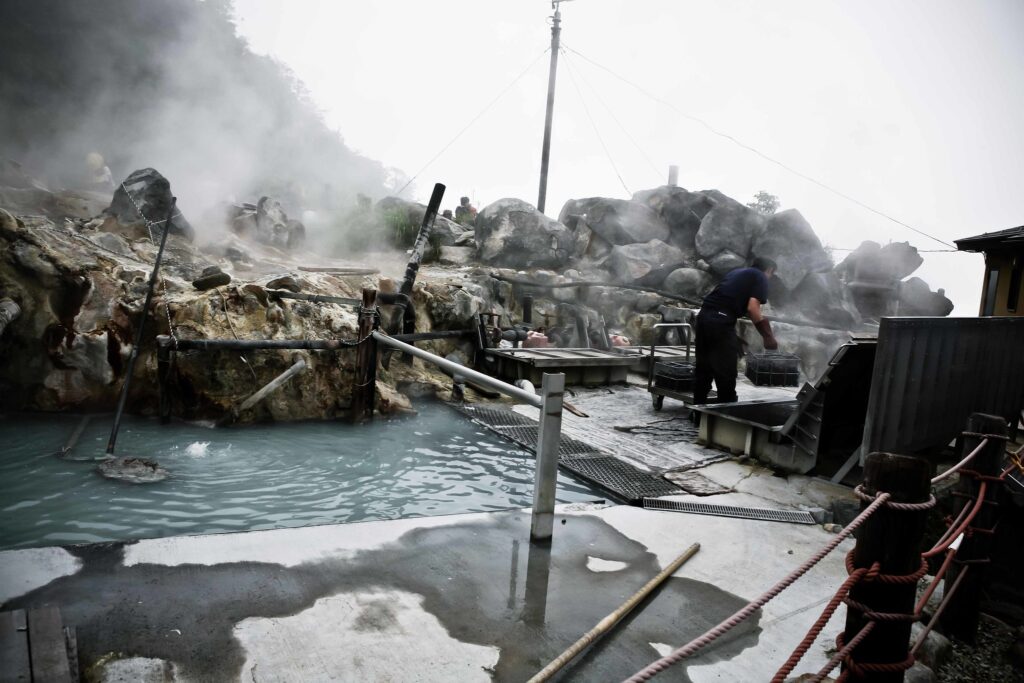
Here you can bathe in a number of hot spring pools, some of which are quite unique, including coffee, red wine and green tea pools. There are nudist areas and some areas where bathing clothes are allowed, which are a great option if you don’t feel like getting naked. The hot springs are famous throughout Japan and even feature in the oldest collection of Japanese poems dating back to 759, the Manyôshu.
36. East Higashi-Gyoen Garden, Tokyo
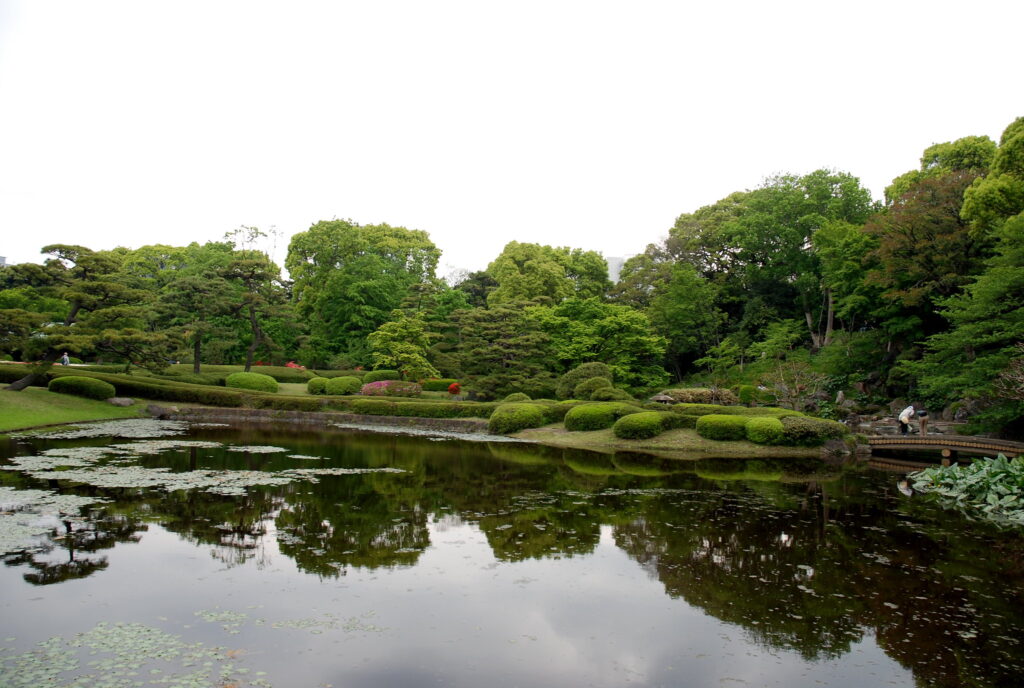
The Imperial Palace Oriental Gardens cover more than 210,000 square metres and are located on the site of the former two innermost defensive walls of Edo Castle, featuring millions of seasonal flowers, sentry boxes, forts and original moats built by the Tokugawa shoguns themselves. It is a spectacle that can be accessed free of charge, which is why it receives millions of visitors a year.
37. Shibuya Crossing, Shibuya
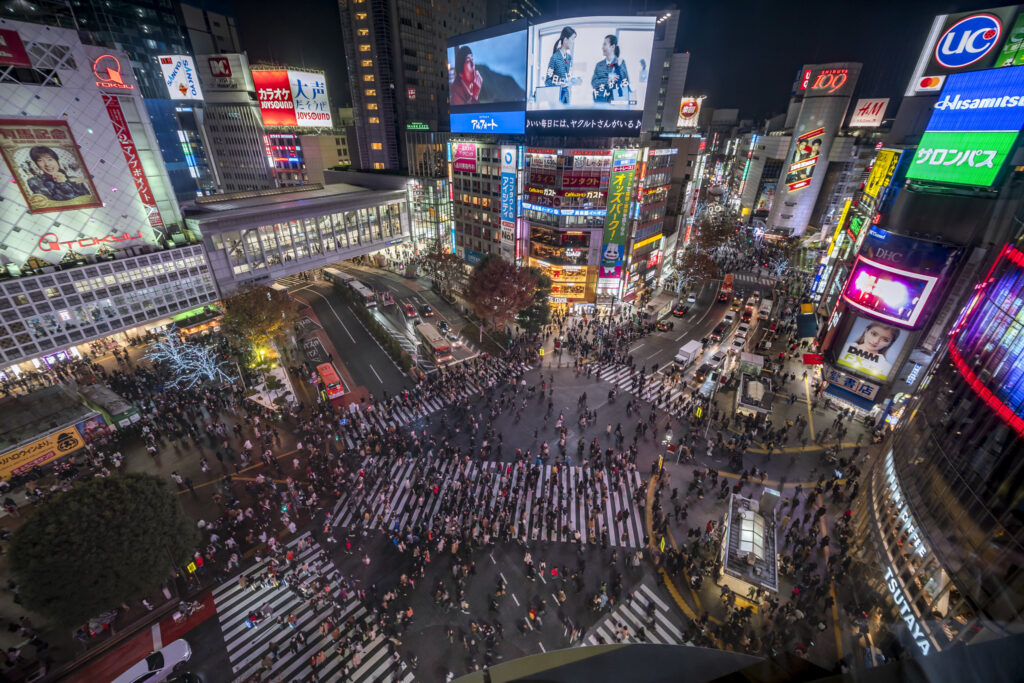
Tokyo’s Shibuya crossing is best known for being the busiest crossing in the world. Around 1 million people pass through this famous crossing every day at an average of 3,000 pedestrians during the 47 seconds it is open. Crossing it while seeing the advertisements is an experience and an attraction for anyone visiting Tokyo. However, being a mere observer, watching the human throngs pass by, is also an experience that will surprise you. It should also be noted that you can only experience the spectacle of the luminous signs in the purest futuristic style at nightfall. This is especially recommended.
38. Tõshõ-gũ Shrine, Nikkō
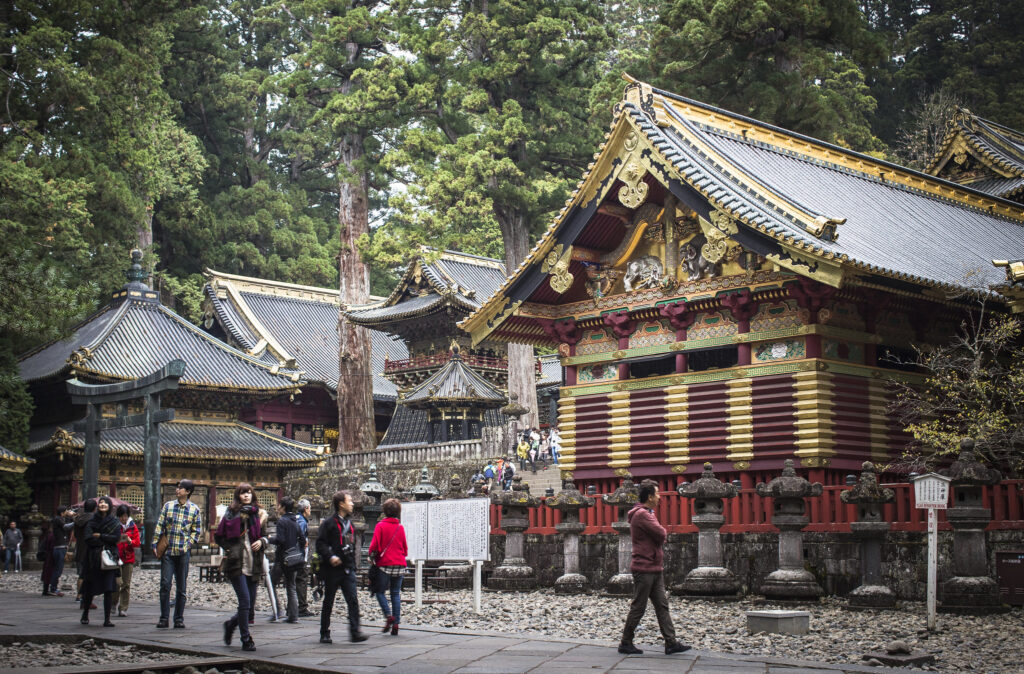
It is the mausoleum of Tokugawa Ieyasu, ruler of Japan until 1868. At first it was a modest shrine but it was enlarged by Ieyasu’s grandson and today it is an immense complex that is definitely worth a visit. It is made up of more than a dozen buildings located in a forest. Its constructions show extraordinary creativity and attention to detail. The bright colours and extravagant carvings contrast with the more spartan design typical of Japan.
39. Tsukiji Market, Tsukiji

The Tsukiji Indoor Market finally closed its doors on 6 October 2018, when it moved to its new location in Toyosu Market. This market was not only the world’s largest fish and seafood market but also a huge market for vegetables, fruits and greens. Today, some restaurants have moved to Toyosu, but the vast majority have kept their premises open in Tsukiji as well. In other words, many of the best restaurants have new premises in Toyosu, but keep their Tsukiji premises open as well. For all these reasons, the “outdoor market” area is still the ideal place to eat sushi or buy sushi-related products.
40. Shinjuku Gyoen National Garden, Tokyo
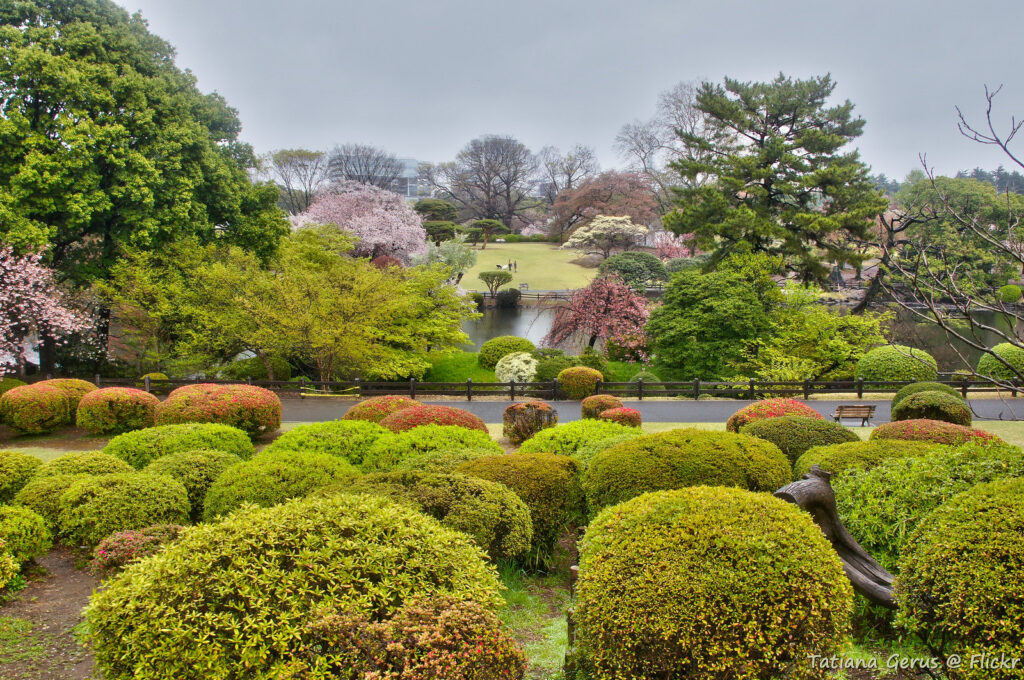
This is one of Tokyo’s great parks and gardens. Located between the Shinjuku and Shibuya districts, it offers an oasis of peace and tranquillity in Japan’s most crowded and stressful city. With a surface area of almost 60 hectares and a circumference of 3.5 km, Shinjuku Gyoen Park has three distinct environments. On the one hand there is the Japanese garden, then there is the English garden and finally the French garden. In addition to these three areas, the park has a greenhouse with some 1700 tropical flowers and plants, an art gallery and a restaurant.
41. Hakone Open-Air Museum, Hakone
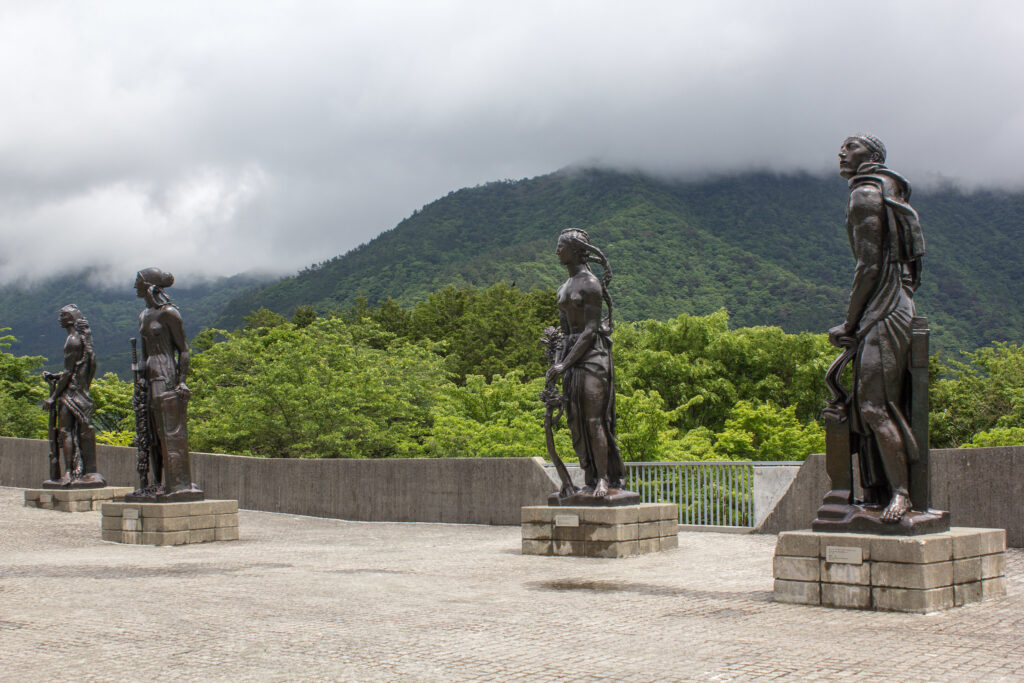
This beautiful museum opened in 1966 and covers more than 70,000 square metres. The best thing about it is that it exhibits some 120 works of art from the 19th and 20th centuries, both by Japanese and international artists. The museum’s intention was always to create a space where nature and art could dialogue, so the environment is a perfect backdrop for the works. The museum is notable for its outdoor works and indoor exhibitions, a fine collection of works by Picasso, as well as collections focusing on Moore and Rosso. The museum also provides visitors with spaces for rest and relaxation such as cafes and restaurants, and even a footbath where visitors can recover from their walks.
42. Naritasan Shinsho-ji, Narita
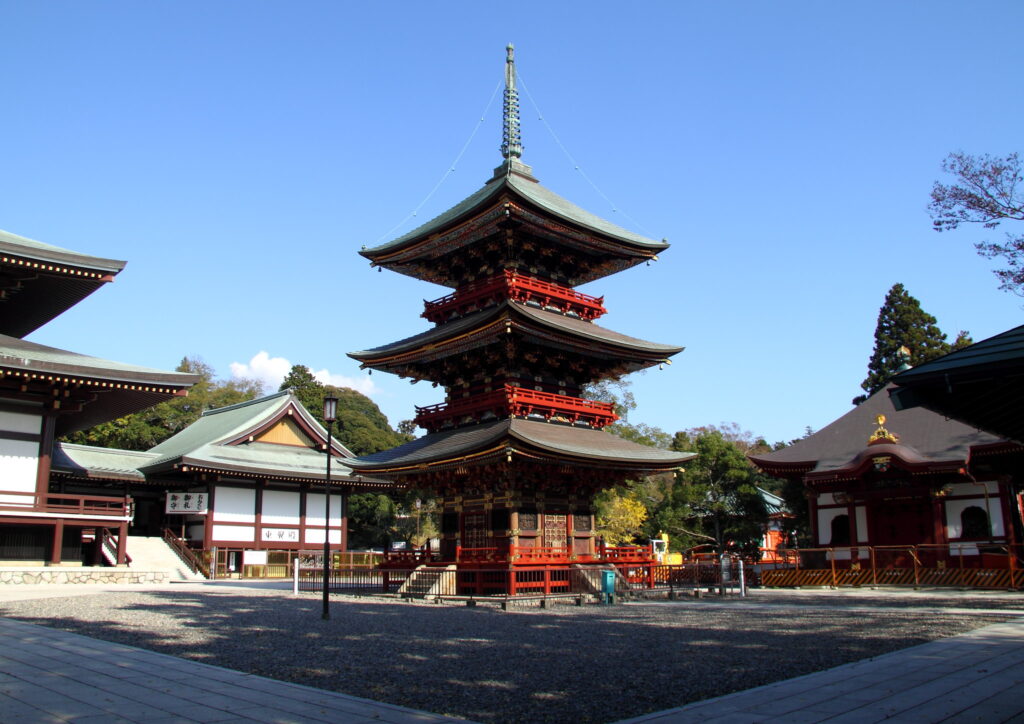
This is a complex of buildings dating back to 940. With its impressive architecture, fairly full calendar of events and proximity to Narita International Airport, Shinshoji Temple is a destination worth adding to your itinerary when travelling to Tokyo. Shinshoji Temple is one of the oldest temples in Japan and hosts many Buddhist ceremonies. Buildings, statues and sacred objects represent centuries of history. One of the main attractions is the Goma Fire Ceremony, a centuries-old tradition where priests pray before long bonfires to help prevent trouble caused by tourists.
43. Tokyo Tower, Tokyo
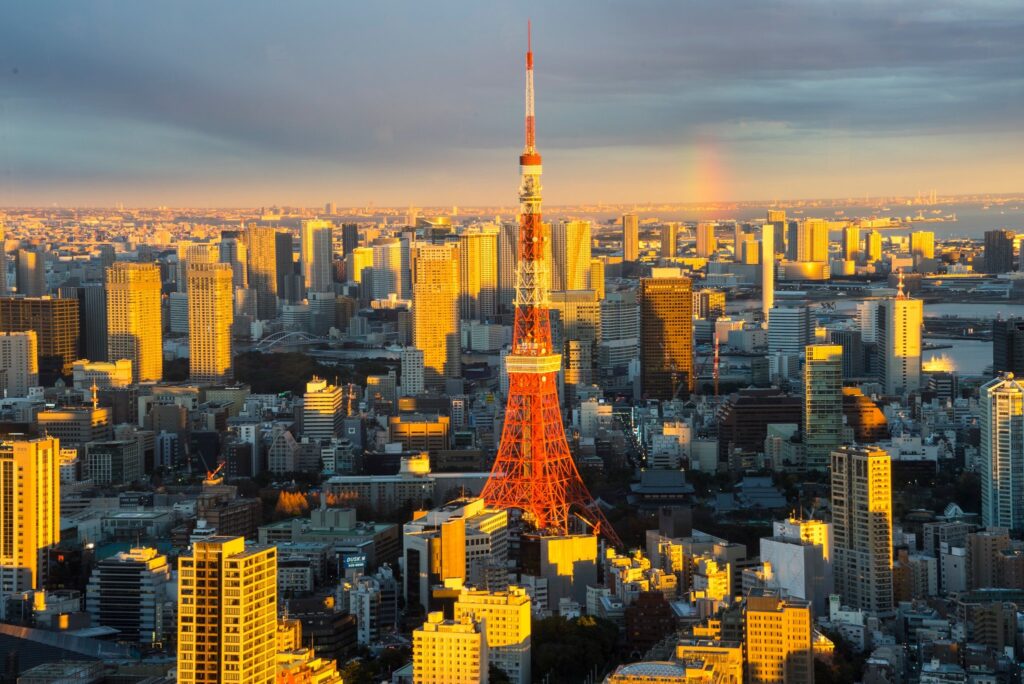
Inspired by the style of the Eiffel Tower, its steel structure reaches 333 metres in height and, although it was originally conceived as a signal transmission tower for radio and television, today it is considered a symbol of the country’s renaissance as a world economic power. Tokyo Tower is located in the special region of Minato and is 333 metres high. It has two observatories, one at 150m, the other at 250m. It also has a wax museum, a trick art gallery, shops and restaurants. But the most interesting side attraction is probably the Tokyo Tower Aquarium and its 50,000 fish comprising 800 species. Adults must pay 820 to access the former and an additional 600 to reach the latter.
44. Sensō-ji, Tokyo
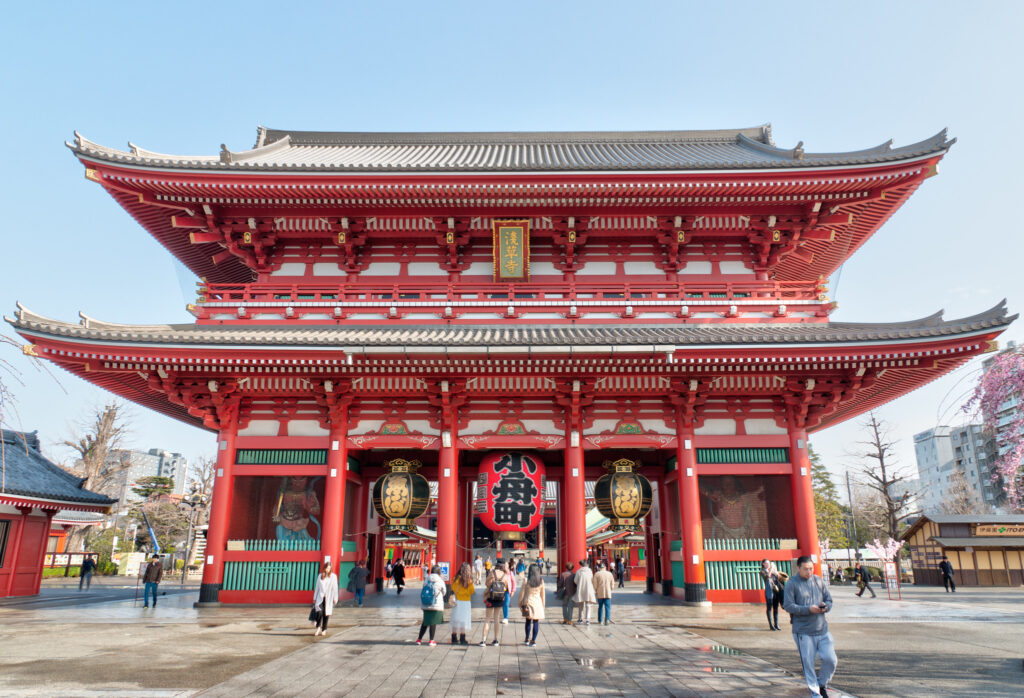
It is the oldest Buddhist temple in Tokyo, dedicated to Kannon, the goddess of mercy. It was built in the year 645, although it was destroyed in the war by US bombing, like the Kokyo, it was rebuilt and today we can enjoy this magnificent temple. Today the temple is visited by a large number of international tourists and in the new Nakamise dori you can find objects typical of Japanese culture, such as T-shirts and Japanese flags. The Sensoji grounds can also be visited at night, combining a magical and spiritual atmosphere that hints at the greatness of Japanese spirituality.
45. Kōtoku-in, Kanagawa
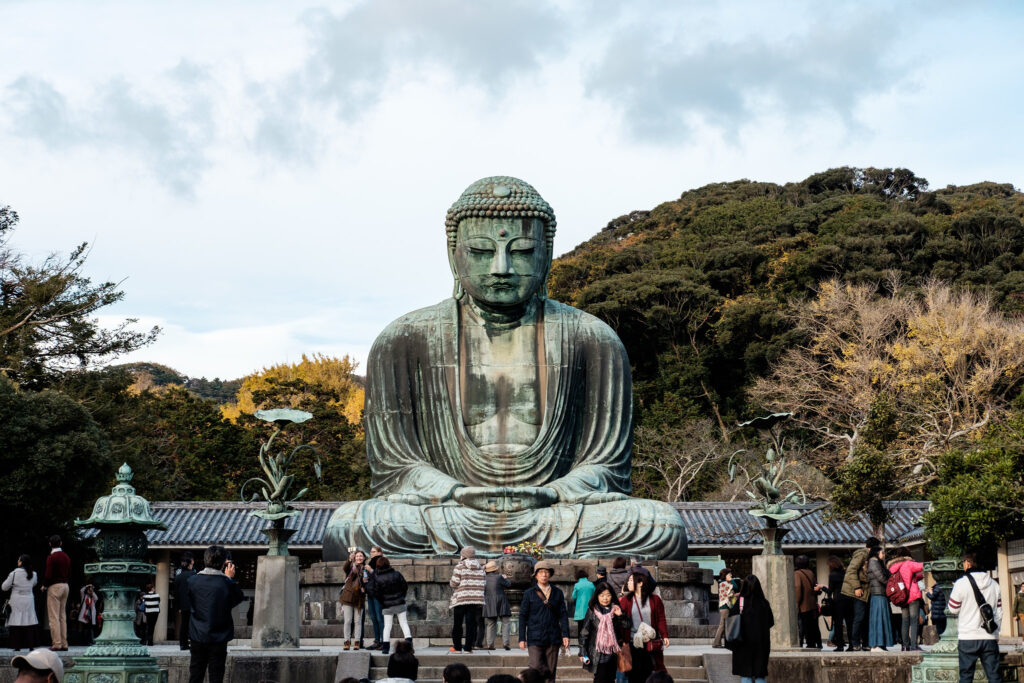
The Kotokuin Temple holds a real gem inside: a huge Buddha figure, the second largest in Japan. The Great Buddha of Kamakura is made of bronze, is 13.35 metres high and is in a seated position on a base raised about 2 metres high. It weighs 93 tons. The interior of the statue is hollow and it is possible to visit the interior for a fee of only 20 yen. One of the most attractive and photogenic features of the statue is the fact that it is outside. It is also surrounded by vegetation in a mountainous area.
46. Tokyo Skytree, Tokyo
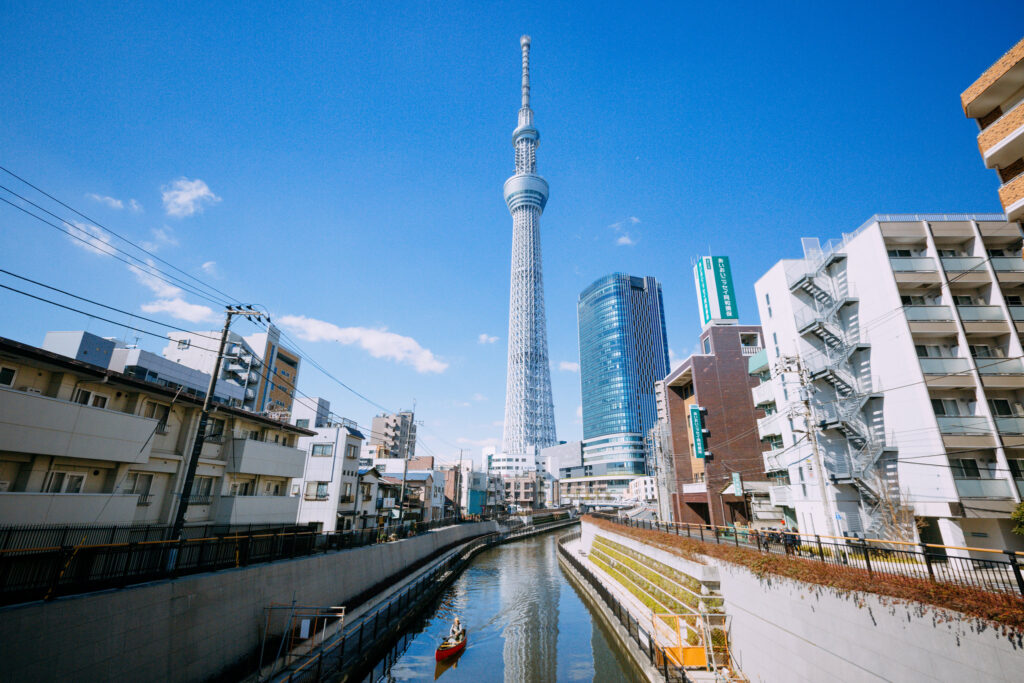
Located in Tokyo’s Taito district, the Tokyo Skytree holds the record as the world’s tallest tower. In addition to becoming a major tourist attraction, the structure’s main purpose is to serve for radio and television broadcasting. It has two observation decks that are accessible to the public. One of the decks is 350 metres high and the other is 450 metres high. Each deck has windows of different shapes, providing a slightly different view. On the 340th floor, there is also a glass floor for those who are feeling a little more daring.
47. Meiji Shrine, Shibuya
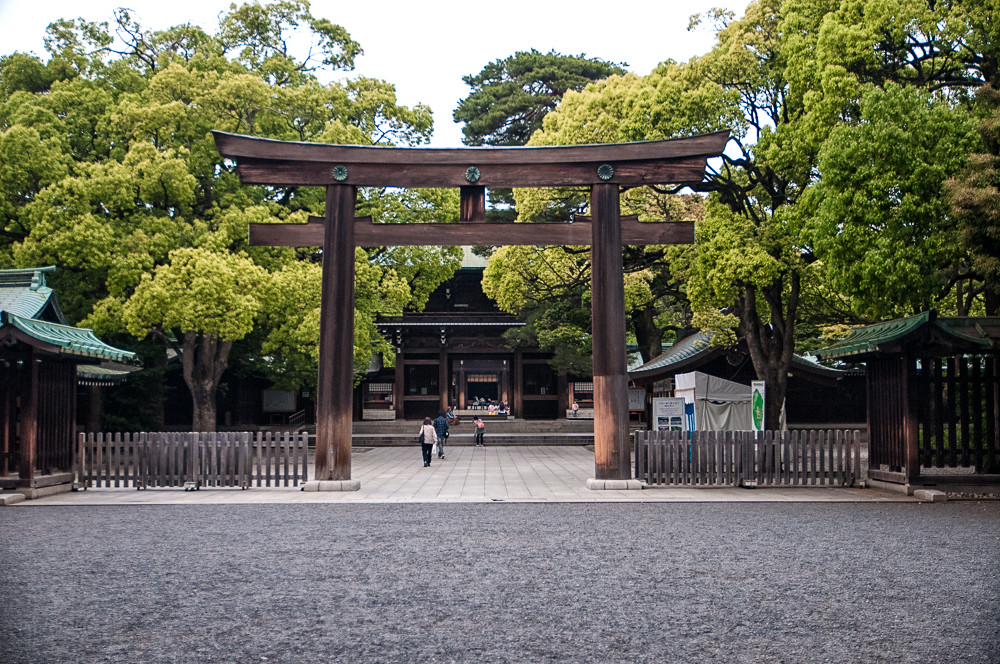
It is the most important shrine in Tokyo and one of the most popular Shinto temples in Japan. The contrasts between the traditional and the modern in Japan are surprising: leaving Harajuku station and finding yourself face to face with the bustling Takeshita-dori and right in front of it the Meiji Shrine with its solemnity and serenity. For this reason, many visitors pass through its gates every day to feel as if they have been transported for a moment to ancient Japan. The Meiji Shrine is located in a forest covering an area of 700,000 m², with more than 120,000 trees of 365 different species. It consists of two main areas Naien (inner enclosure) and Gaien (outer enclosure).
48. Ueno Park, Tokyo

It is a public park in northeast Tokyo that is very popular with Tokyoites and tourists alike. Its museums, cherry trees and, of course, the panda bears in its zoo make many people decide to spend some time in this park. The park is home to the Ueno Zoo, Tokyo National Museum, National Science Museum, Shitamachi Museum, Oriental Museum, National Museum of Western Art and the Tokyo Metropolitan Art Gallery. The best time to visit the park is in February and March, when the cherry blossoms are in full bloom. At this time of year, the scenery is breathtakingly beautiful.
49. Yoyogi Park, Shibuya
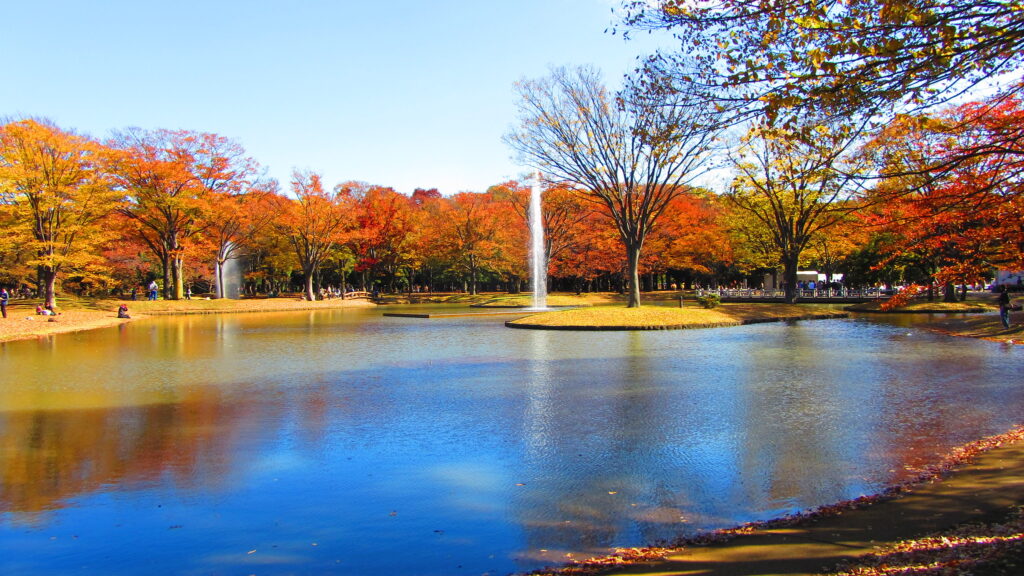
It is one of the largest parks in Tokyo and is very close to Meiji Shrine and Harajuku Station. It is not a traditional Japanese garden but more of a western-style park, with large grassy areas for all kinds of outdoor activities. Sunday is the ideal day to visit Yoyogi, as you can witness a spectacle that you will hardly find anywhere else in the world: the most disparate and bizarre urban tribes gather there to make music, take pictures and, basically, show off. And also on Sundays, around the park you’ll find all kinds of bands and street musicians trying to make a name for themselves and sell some of their records.
50. Tokyo Disneyland, Tokyo

Disneyland in Japan started in the early 1980s with the Tokyo Disneyland park. However, over time it has been expanding and today we can talk about Tokyo Disney Resort, formed by 2 amusement parks, Tokyo Disneyland and Tokyo DisneySea. In the Tokyo Disneyland park you can find the attractions that have made the Mickey Mouse parks famous, such as Pirates of the Caribbean, Small World, Splash Mountain and Space Mountain. Tokyo DisneySea is a sea-inspired park with attractions unique to Tokyo.
51. National Museum of Emerging Science and Innovation, Tokyo
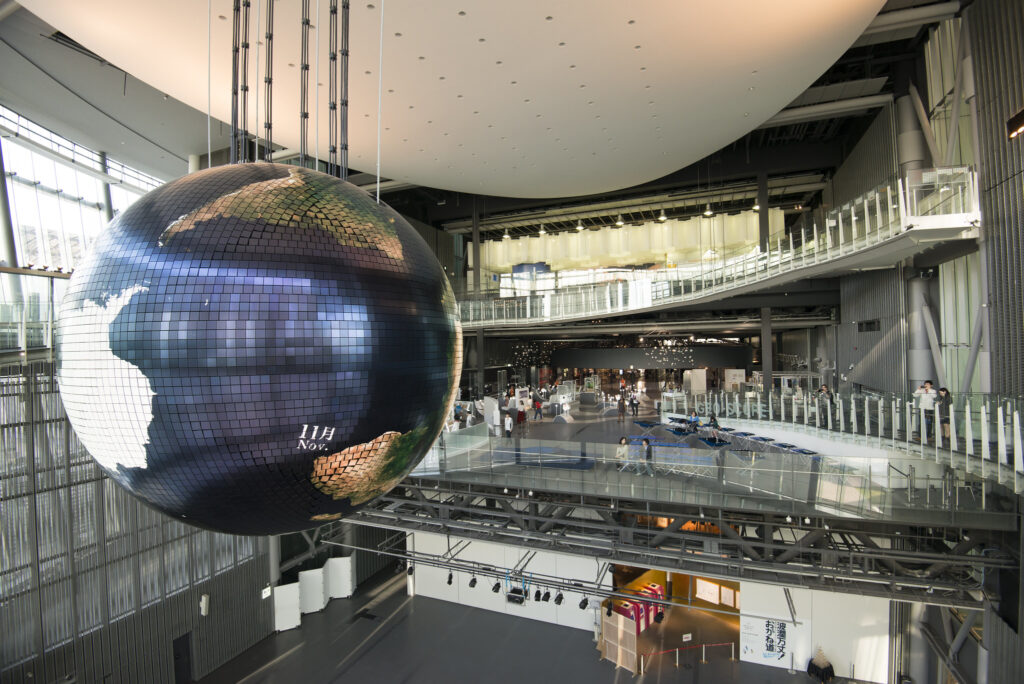
Interactive exhibitions, talks and scientific experiments allow visitors to get a closer look at the latest technologies, show the latest advances in environmental issues, space exploration or life sciences, among others. We find ASIMO, the well-known humanoid robot that was “born” thanks to HONDA in 2000 and has been working as a scientific communicator at Miraikan since January 2002, giving demonstrations at the exhibition. But ASIMO is not the only exceptional science communicator at Miraikan. On the third floor of the museum are Otonaroid® and Telenoid®, remote-controlled androids with which you can experience a face-to-face discussion about the future of robotics – if you’re up to it.
52. Hitachi Seaside Park, Hitachinaka
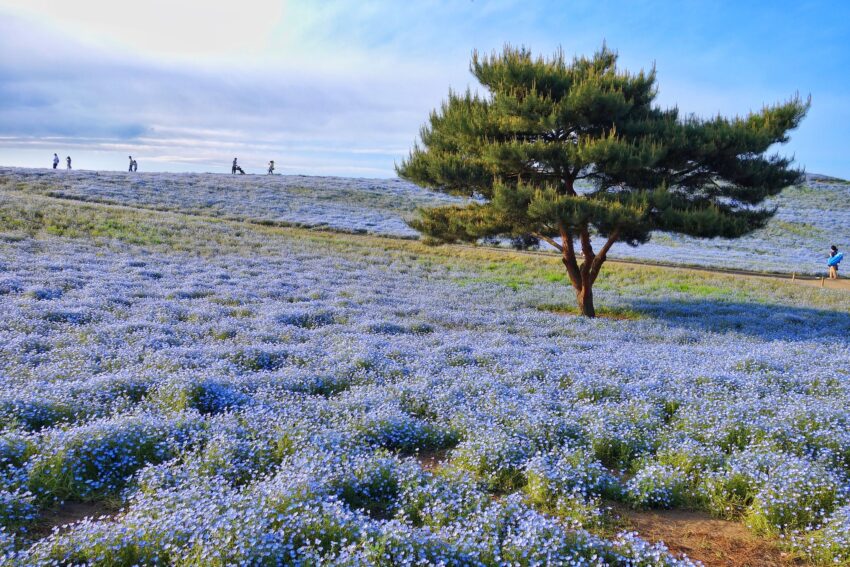
It is a floral park covering nine acres of flowers surrounded by nothing but their own kind. A spectacular assortment divided by colour that changes hue with each season. The park is particularly famous for its blue nemophilas, a species of flower with almost translucent blue and white petals that, planted by the thousands in the fields of Hitachi, seem to form a reflection of the sky on earth. The flowering season takes place in the spring, when the park receives the most visitors. Hitachi Seaside is designed to guide visitors on long walks, to take them through subtle and colourful variations of their own mood.
53. Ghibli Museum, Tokyo
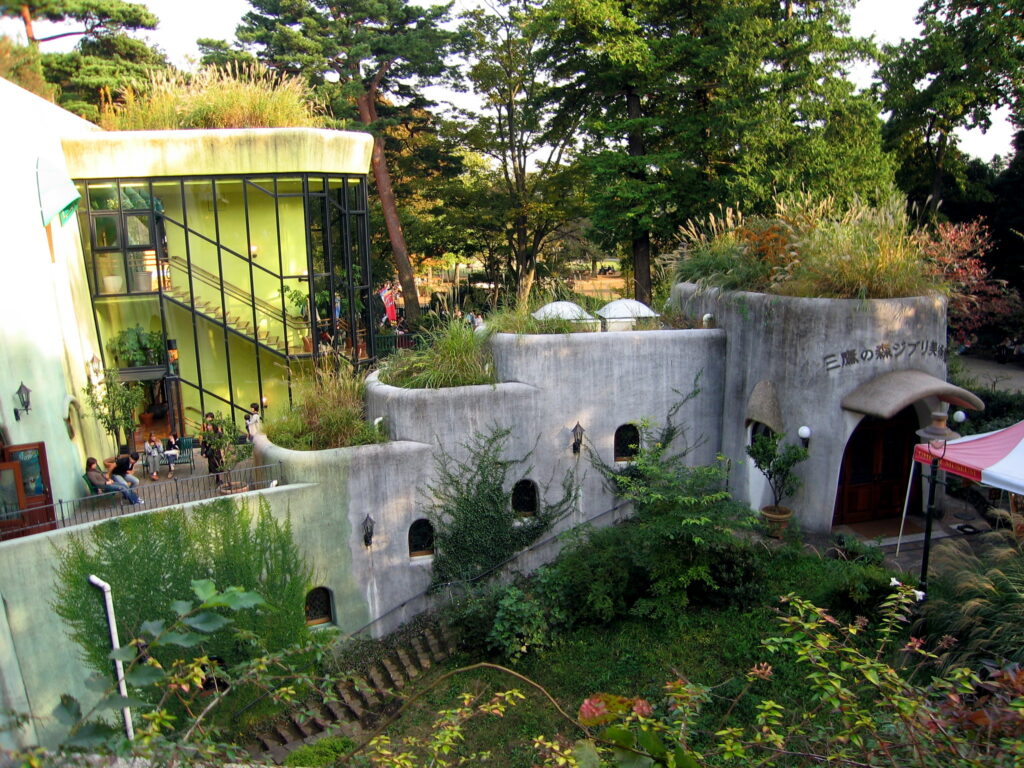
The Ghibli Museum in Mitaka’s Inokashira Park is dedicated to the anime works of Studio Ghibli. Opened on 1 October 2001, the museum is a must-see for children and adults who have enjoyed such iconic films as My Neighbour Totoro, Laputa, Castle in the Sky, Spirited Away and many others. Tickets to the Ghibli Museum are only valid for a specific date and time. That is why they are not sold over the counter, but in advance, which is why they are the hardest to get, no doubt. It is important to note that it is forbidden to take photographs and videos inside the museum.
54. Kegon Falls, Tochigi
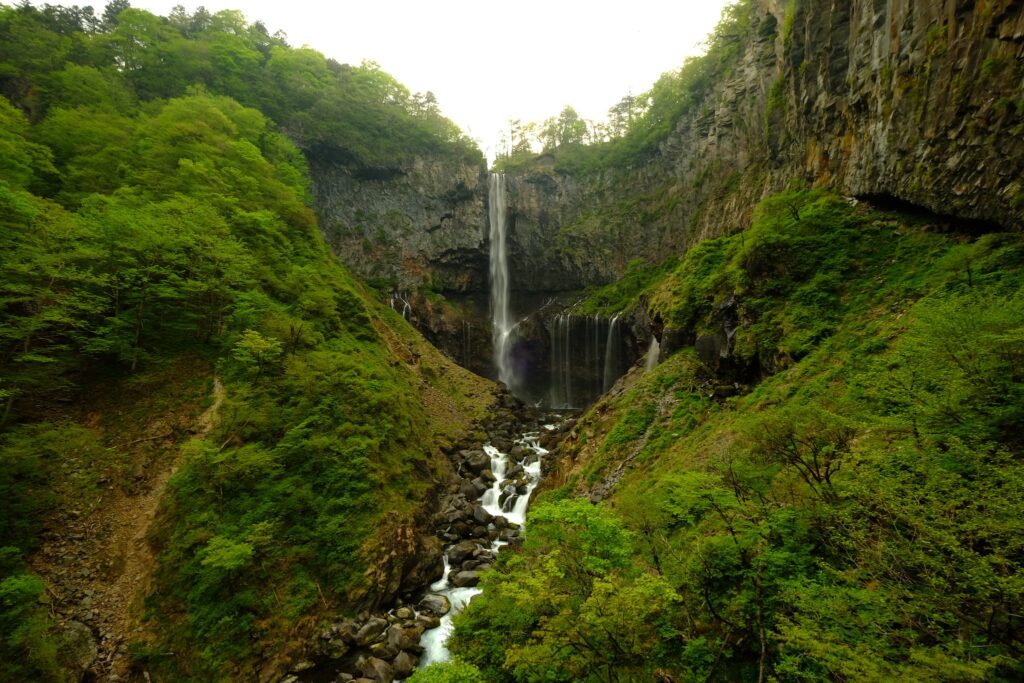
This waterfall in Nikko National Park originated more than 20 000 years ago as the main outlet of Lake Chuzenji. It is about 100 metres high and is ranked as one of the three largest waterfalls in Japan. To get the best view of the falls, you have two options, a free observation deck where you can walk or access the observation deck at the bottom of the falls for ¥550 and a lift to descend 100 metres. The waterfall can also be seen from the Akechidaira Observatory, which costs ¥730 by cable car from Akechidaira Kogen. From there we had a great view of the mountains, the waterfall and the rest of the park.
55. Ashikaga Flower Park, Ashikaga
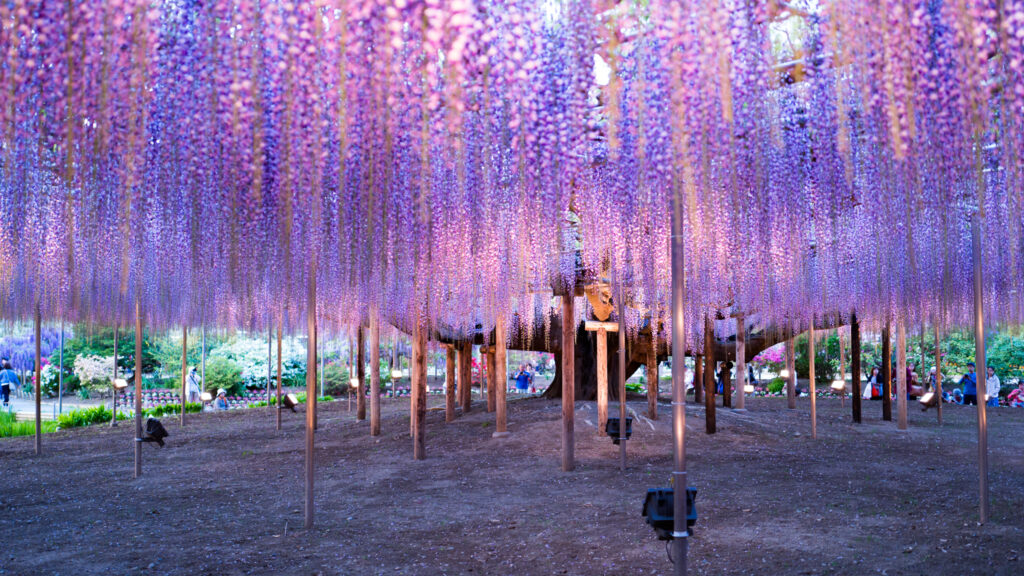
Ashikaga Flower Park is world famous for its wide variety of wisteria flowers in all their magnificence. Wisteria is a climbing plant that leaves beautiful flowers hanging down. Not only can these marvellous flowers be seen in their different states and colours, but they are also decorated like a great work of art, giving the viewer a magnificent sight. The park has wisteria trees dating back 130 years. In spring, the flowers are at their peak, which makes this park visited by thousands of people from all over Japan. But even more amazing and beautiful is the special event that takes place from November to February every year.
The Best Places in Kyūshū
56. Yakushima, Kagoshima

Yakushima is one of the islands of the Ōsumi-shotō group, about 100 kilometres south of Kyushu. Its charm lies in the wonderful array of natural experiences it offers, especially its ancient forests. The place is ideal for nature lovers, who will find trails of varying levels on the island. If you wish, you can spend the night on different trails. Most of the trails have cabins with basic facilities where you can spend the night. To enjoy this experience, we recommend that you buy a local topographical map and find out the location of the huts as well as the routes.
57. Fukuoka Castle, Fukuoka
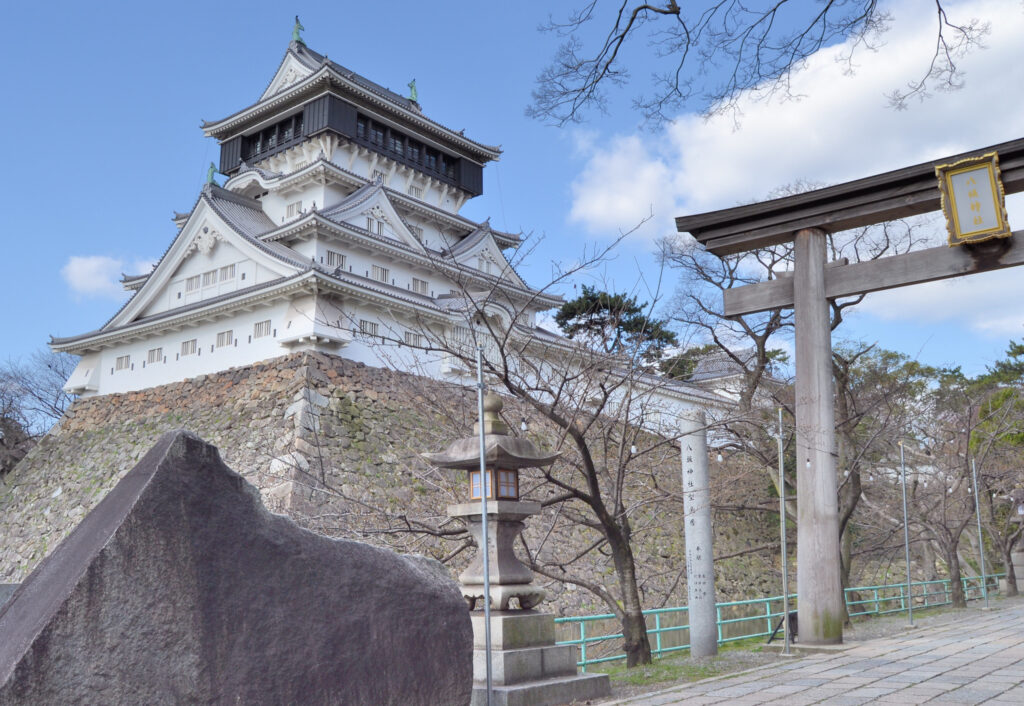
The Fukuoka Castle Ruins of Fukuoka are located in Maizuru Park. The original castle was the largest castle in Kyushu during the Edo period but has not been rebuilt since it was destroyed in the Meiji period reformation as it was considered a symbol of feudalism. The castle grounds are home to hundreds of cherry trees and an annual illumination festival is held here during the sakura season. This is when most visitors come, but the rest of the year you can enjoy the grounds without the thousands of people who come to see the cherry blossoms.
58. Hakata Gion Yamakasa, Fukuoka
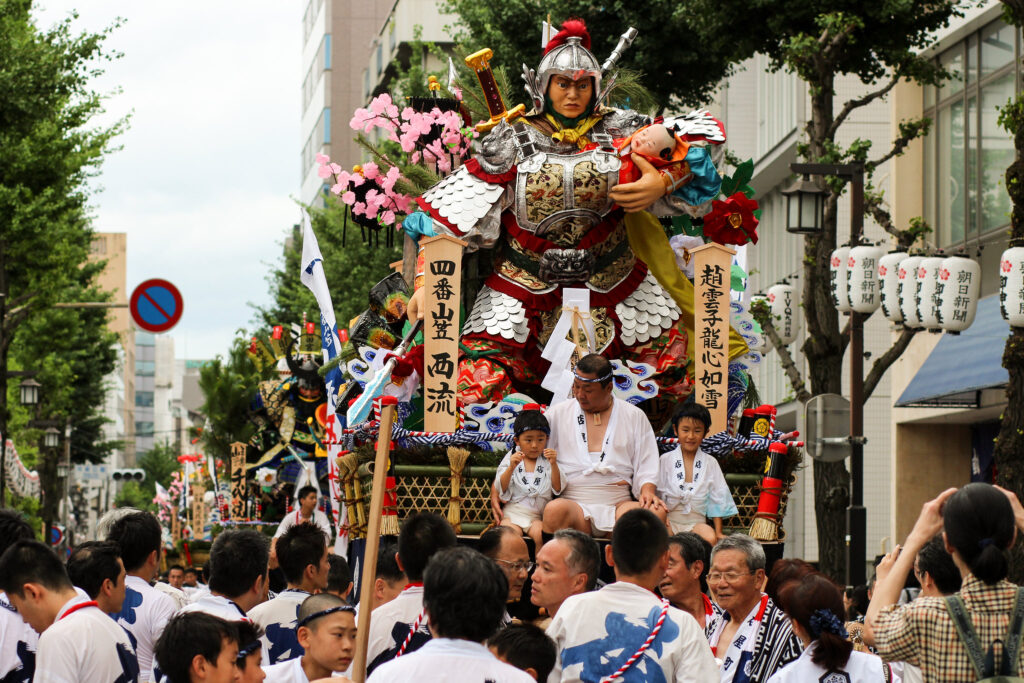
“Gion Yamakasa” is one of Fukuoka’s most anticipated festivals, held in the Hakata district from 1 to 15 July. The climax takes place at 04:59 (exactly) on 15 July, when thousands of men in loincloths from seven districts parade through the streets carrying decorative floats weighing one tonne. If you look closely at the different roles and how the runners change positions, you can see the splendid teamwork. If you happen to be travelling on the same dates, we recommend you give it a try, you won’t regret it.
59. Okinawa Churaumi Aquarium, Okinawa
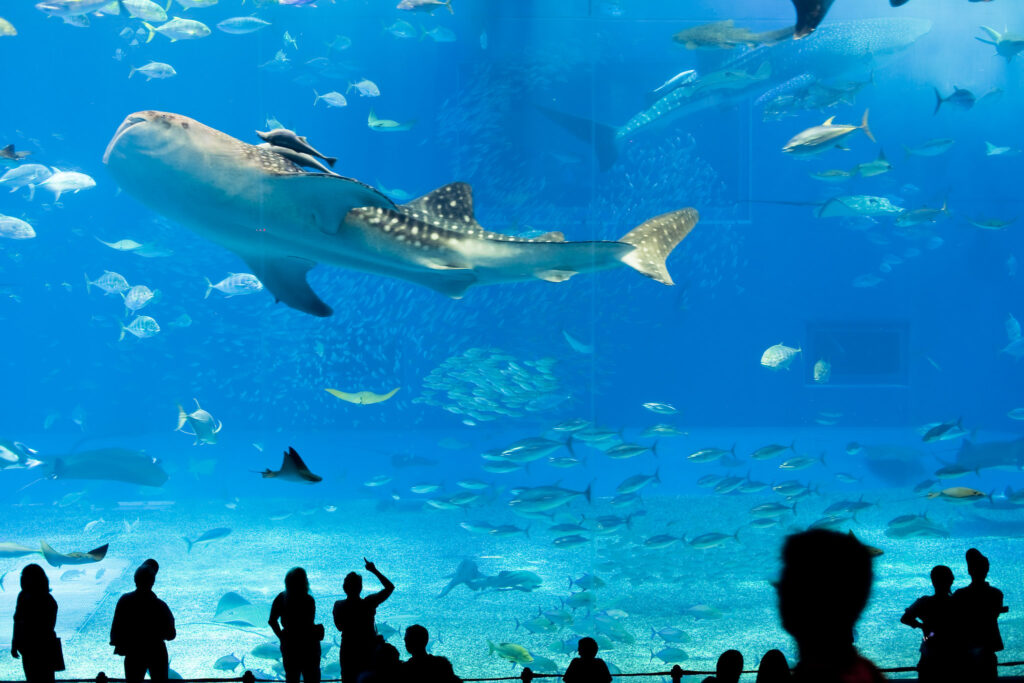
Churaumi is the second largest aquarium in the world. The main attraction is the whale sharks, which along with the one in Georgia (USA) is the only one that exhibits this animal. The Kuroshio tank is famous for its huge 22-metre bay that allows the largest species to be observed. The four floors of the aquarium have many interesting exhibits. Among them is a tank for observing deep-sea species, which usually can only be observed by submarine. In another part of the aquarium there is an area where you can touch some species, such as dolphins and starfish.
60. Huis Ten Bosch, Nagasaki
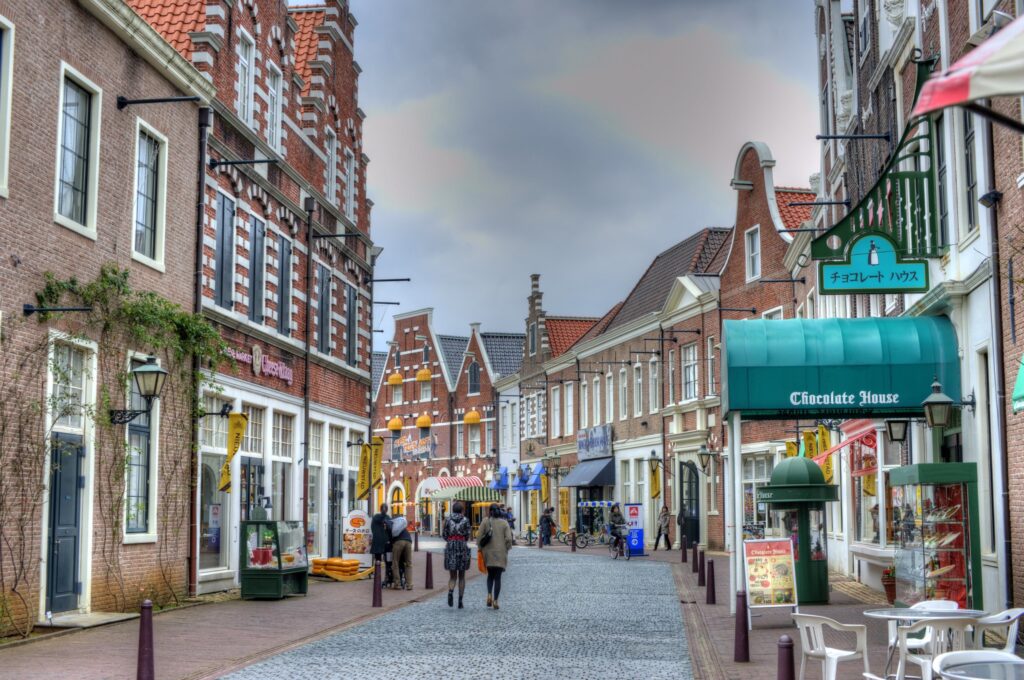
It is a theme park located in Nagasaki Prefecture where a village in the Netherlands is recreated. The park holds two major events during the year; the Kingdom of Flowers (from March to June) and the Kingdom of Light (from November to February). Special events include amazing light displays, amusements and parades. For people who like extreme activities, the park has a roller coaster and several haunted houses. Huis Ten Bosch also has several Western-style restaurants, six European-style hotels, a cruise ship, art museums, a Ferris wheel, theatres and an observatory overlooking the entire area.
61. Takachiho Gorge, Takachiho
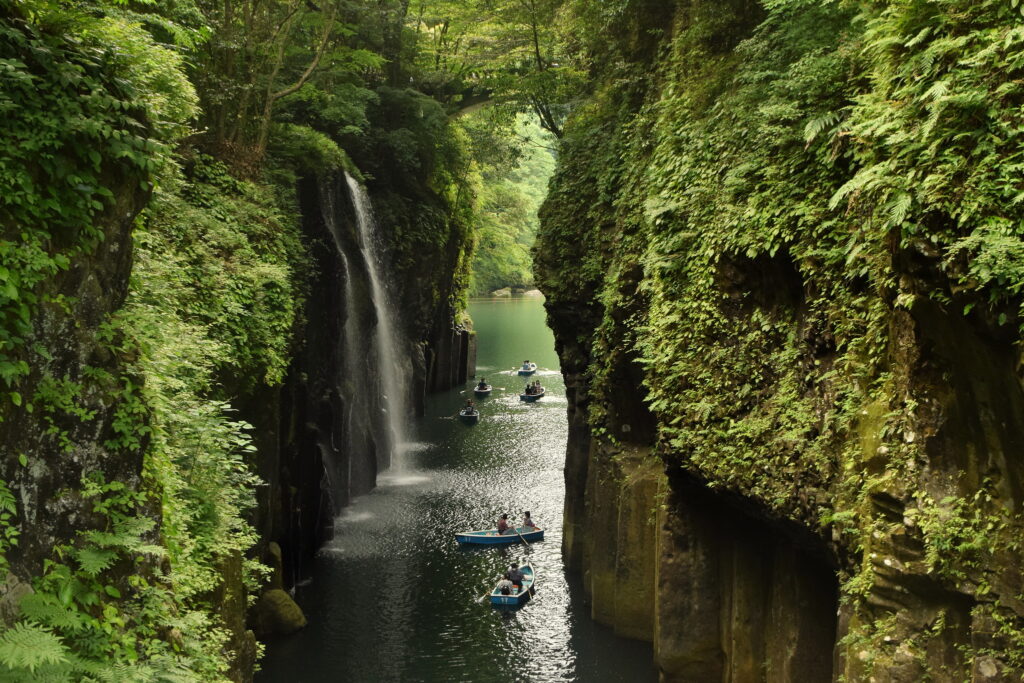
A narrow canyon through which the Gokase River flows, where nature has more than one surprise in store with its crystal-clear turquoise waters. Its steep cliffs, covered with dense vegetation, filter the light creating a magical atmosphere that reaches its peak thanks to the 17-metre high Minainotaki waterfall and the basalt column formations. Alongside the gorge there is a promenade with an extraordinary view, but there is nothing better than renting a boat to take you into the gorge and see the waterfall up close. In spring the cherry trees and azaleas add colour to the landscape, while in autumn the reddish and yellowish tones of the leaves take over the place.
The Best Places in Shikoku
62. Naoshima, Kagawa
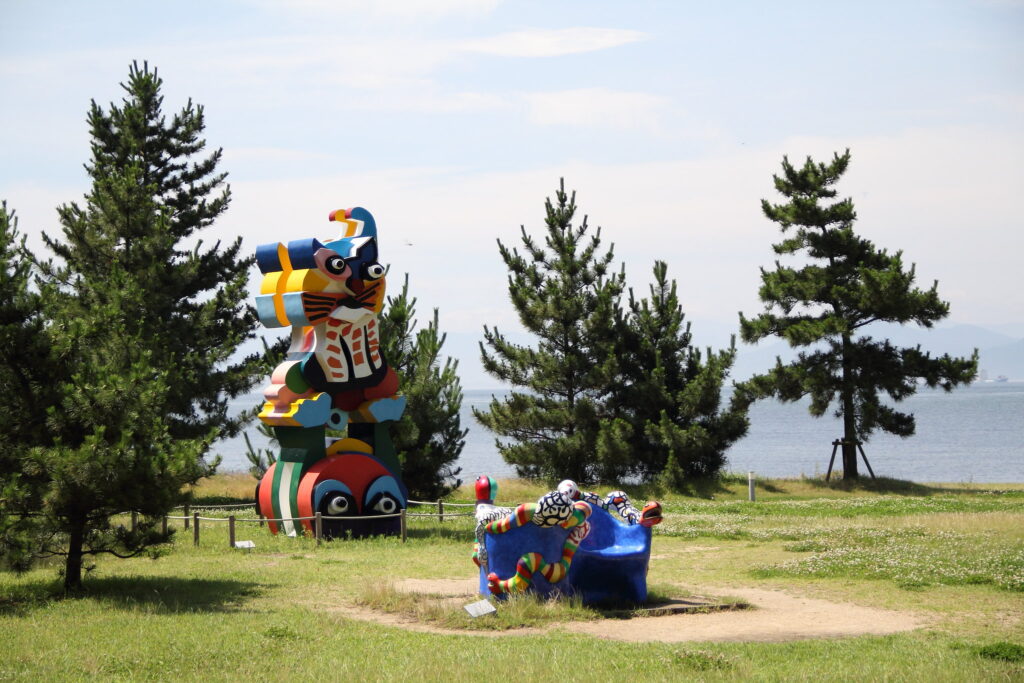
It is known worldwide as “the island of art”. The island’s nickname is not only because of its many museums and art installations, but also because it is one of the main venues for the Setouchi Triennale, a contemporary art festival that has been held every three years since 2010. A visit to Naoshima can be divided into three specific areas: the Miyanoura harbour area, the Benesse House museum area and the traditional Honmura district. Please note that photography is not allowed in any of Naoshima’s museums and art installations (except for the open-air ones). In fact, some of these museums will give you a bag to keep your camera in.
If you loved this article or found it useful, don’t forget to visit and subscribe to my social media for more useful content. Follow us on Google My Business, YouTube, Instagram, Pinterest, Twitter, Facebook or Reddit and subscribe to our receive our free website content.

